Design and Construction of Mini Hydro Power Plant in Kosovo
VerifiedAdded on 2023/06/04
|21
|3645
|81
AI Summary
This report focuses on the design and construction of a mini hydro power plant in Kosovo with propeller turbines. It discusses the need for alternative energy sources and the technical performance of the system. The report covers the conceptual and preliminary design, determination of data from the site, water flow-rate estimation, net head estimation, speed determination in hydro-turbines, and detailed design of the mini hydro power plant. It also includes information on the construction works, functional analysis, testing of the system, and validation.
Contribute Materials
Your contribution can guide someone’s learning journey. Share your
documents today.
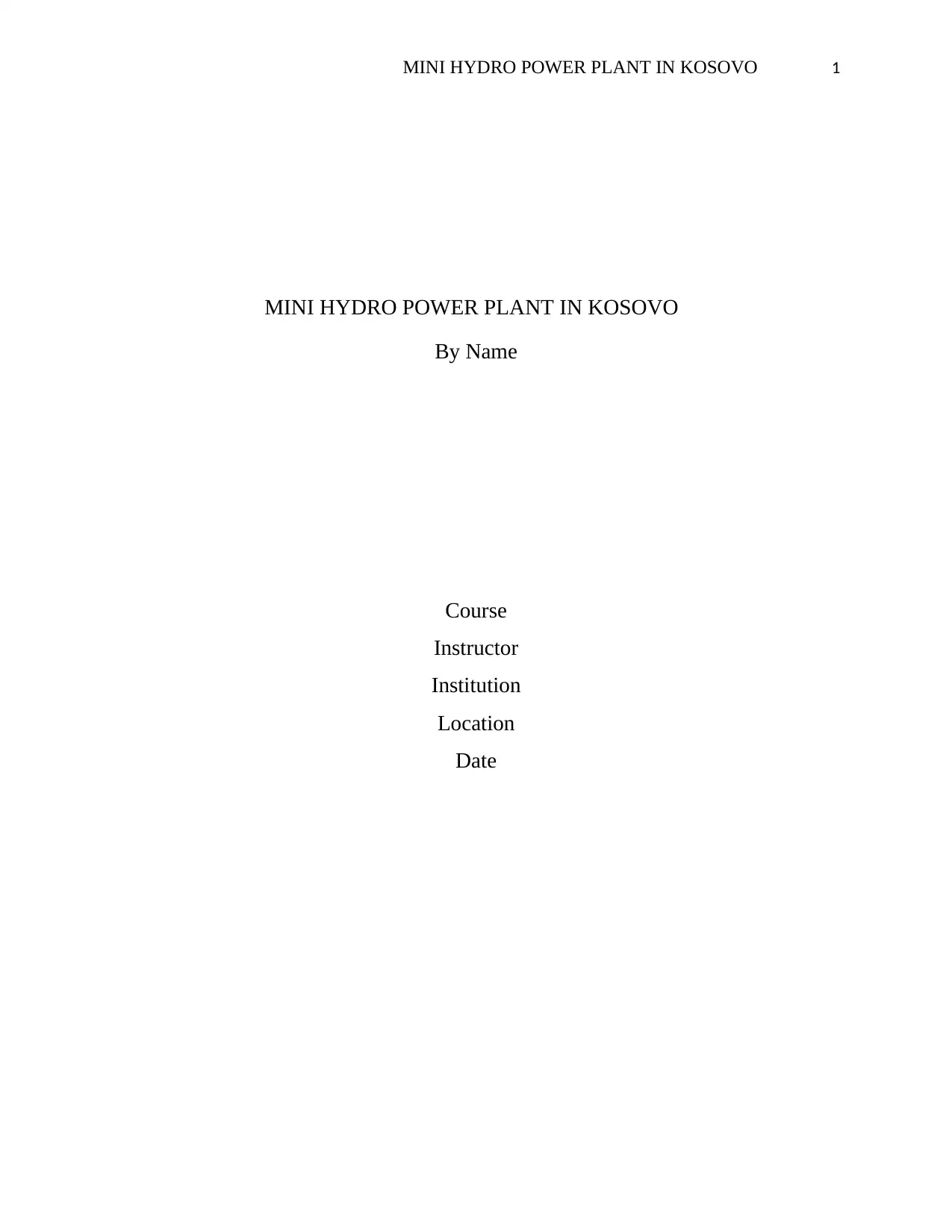
MINI HYDRO POWER PLANT IN KOSOVO 1
MINI HYDRO POWER PLANT IN KOSOVO
By Name
Course
Instructor
Institution
Location
Date
MINI HYDRO POWER PLANT IN KOSOVO
By Name
Course
Instructor
Institution
Location
Date
Secure Best Marks with AI Grader
Need help grading? Try our AI Grader for instant feedback on your assignments.
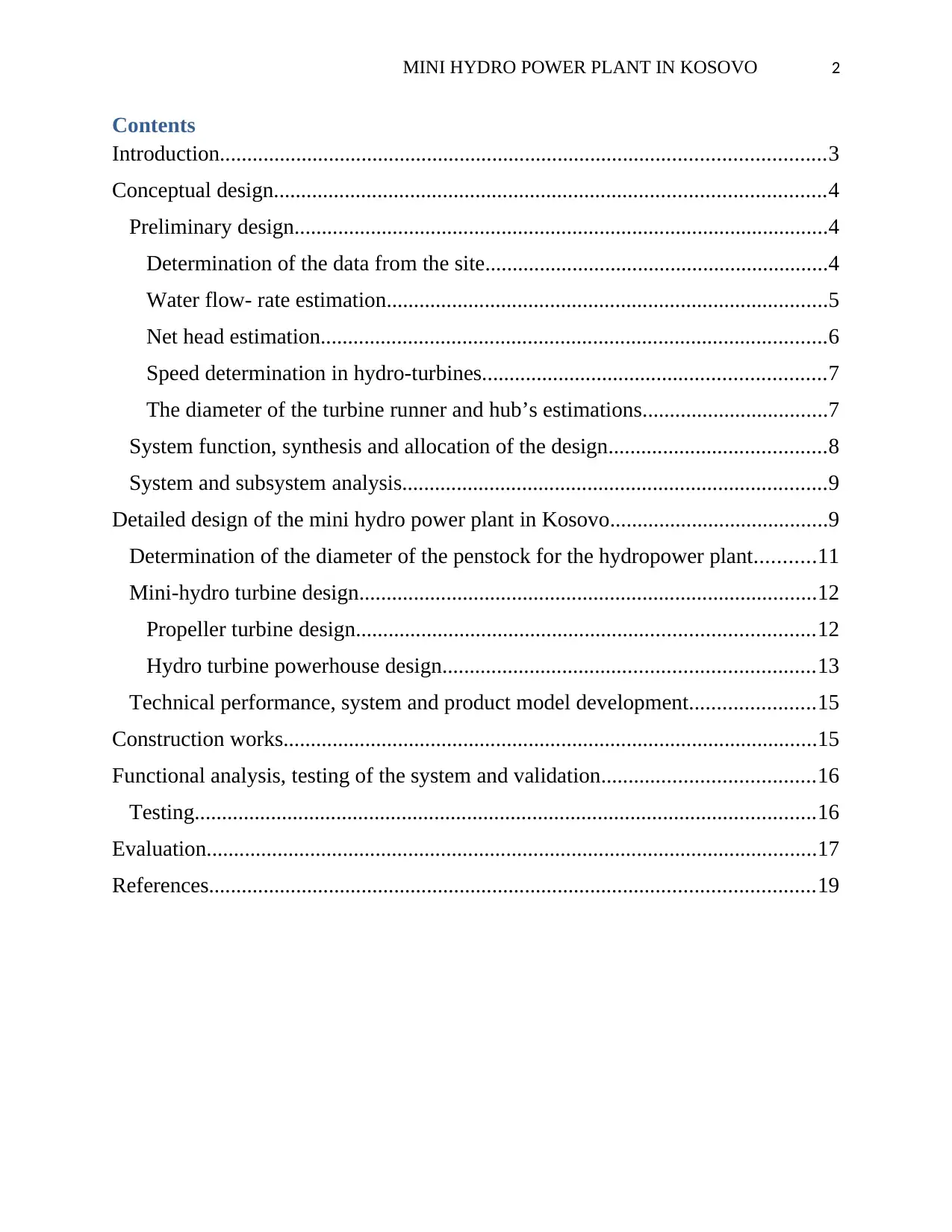
MINI HYDRO POWER PLANT IN KOSOVO 2
Contents
Introduction...............................................................................................................3
Conceptual design.....................................................................................................4
Preliminary design..................................................................................................4
Determination of the data from the site...............................................................4
Water flow- rate estimation.................................................................................5
Net head estimation.............................................................................................6
Speed determination in hydro-turbines...............................................................7
The diameter of the turbine runner and hub’s estimations..................................7
System function, synthesis and allocation of the design........................................8
System and subsystem analysis..............................................................................9
Detailed design of the mini hydro power plant in Kosovo........................................9
Determination of the diameter of the penstock for the hydropower plant...........11
Mini-hydro turbine design....................................................................................12
Propeller turbine design....................................................................................12
Hydro turbine powerhouse design....................................................................13
Technical performance, system and product model development.......................15
Construction works..................................................................................................15
Functional analysis, testing of the system and validation.......................................16
Testing..................................................................................................................16
Evaluation................................................................................................................17
References...............................................................................................................19
Contents
Introduction...............................................................................................................3
Conceptual design.....................................................................................................4
Preliminary design..................................................................................................4
Determination of the data from the site...............................................................4
Water flow- rate estimation.................................................................................5
Net head estimation.............................................................................................6
Speed determination in hydro-turbines...............................................................7
The diameter of the turbine runner and hub’s estimations..................................7
System function, synthesis and allocation of the design........................................8
System and subsystem analysis..............................................................................9
Detailed design of the mini hydro power plant in Kosovo........................................9
Determination of the diameter of the penstock for the hydropower plant...........11
Mini-hydro turbine design....................................................................................12
Propeller turbine design....................................................................................12
Hydro turbine powerhouse design....................................................................13
Technical performance, system and product model development.......................15
Construction works..................................................................................................15
Functional analysis, testing of the system and validation.......................................16
Testing..................................................................................................................16
Evaluation................................................................................................................17
References...............................................................................................................19
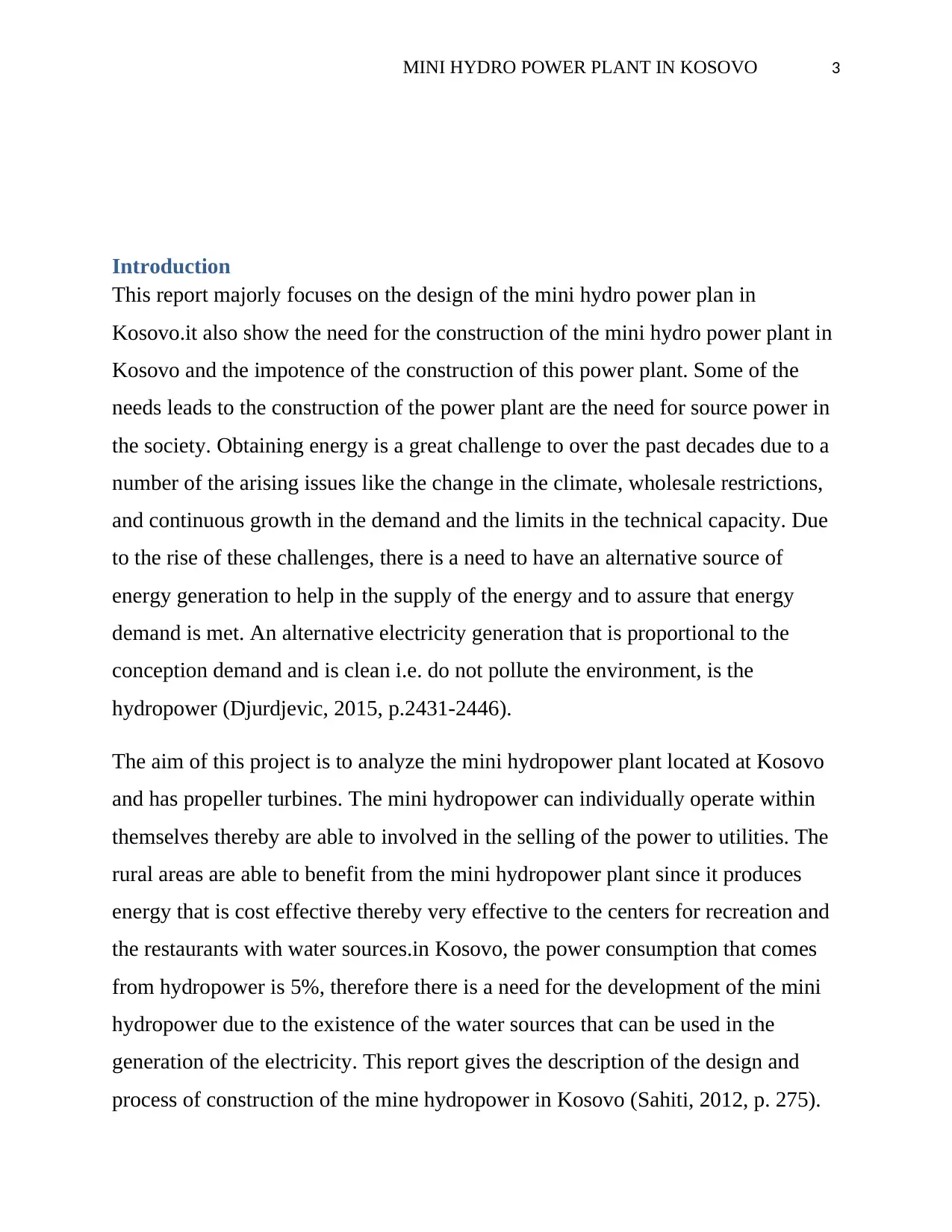
MINI HYDRO POWER PLANT IN KOSOVO 3
Introduction
This report majorly focuses on the design of the mini hydro power plan in
Kosovo.it also show the need for the construction of the mini hydro power plant in
Kosovo and the impotence of the construction of this power plant. Some of the
needs leads to the construction of the power plant are the need for source power in
the society. Obtaining energy is a great challenge to over the past decades due to a
number of the arising issues like the change in the climate, wholesale restrictions,
and continuous growth in the demand and the limits in the technical capacity. Due
to the rise of these challenges, there is a need to have an alternative source of
energy generation to help in the supply of the energy and to assure that energy
demand is met. An alternative electricity generation that is proportional to the
conception demand and is clean i.e. do not pollute the environment, is the
hydropower (Djurdjevic, 2015, p.2431-2446).
The aim of this project is to analyze the mini hydropower plant located at Kosovo
and has propeller turbines. The mini hydropower can individually operate within
themselves thereby are able to involved in the selling of the power to utilities. The
rural areas are able to benefit from the mini hydropower plant since it produces
energy that is cost effective thereby very effective to the centers for recreation and
the restaurants with water sources.in Kosovo, the power consumption that comes
from hydropower is 5%, therefore there is a need for the development of the mini
hydropower due to the existence of the water sources that can be used in the
generation of the electricity. This report gives the description of the design and
process of construction of the mine hydropower in Kosovo (Sahiti, 2012, p. 275).
Introduction
This report majorly focuses on the design of the mini hydro power plan in
Kosovo.it also show the need for the construction of the mini hydro power plant in
Kosovo and the impotence of the construction of this power plant. Some of the
needs leads to the construction of the power plant are the need for source power in
the society. Obtaining energy is a great challenge to over the past decades due to a
number of the arising issues like the change in the climate, wholesale restrictions,
and continuous growth in the demand and the limits in the technical capacity. Due
to the rise of these challenges, there is a need to have an alternative source of
energy generation to help in the supply of the energy and to assure that energy
demand is met. An alternative electricity generation that is proportional to the
conception demand and is clean i.e. do not pollute the environment, is the
hydropower (Djurdjevic, 2015, p.2431-2446).
The aim of this project is to analyze the mini hydropower plant located at Kosovo
and has propeller turbines. The mini hydropower can individually operate within
themselves thereby are able to involved in the selling of the power to utilities. The
rural areas are able to benefit from the mini hydropower plant since it produces
energy that is cost effective thereby very effective to the centers for recreation and
the restaurants with water sources.in Kosovo, the power consumption that comes
from hydropower is 5%, therefore there is a need for the development of the mini
hydropower due to the existence of the water sources that can be used in the
generation of the electricity. This report gives the description of the design and
process of construction of the mine hydropower in Kosovo (Sahiti, 2012, p. 275).
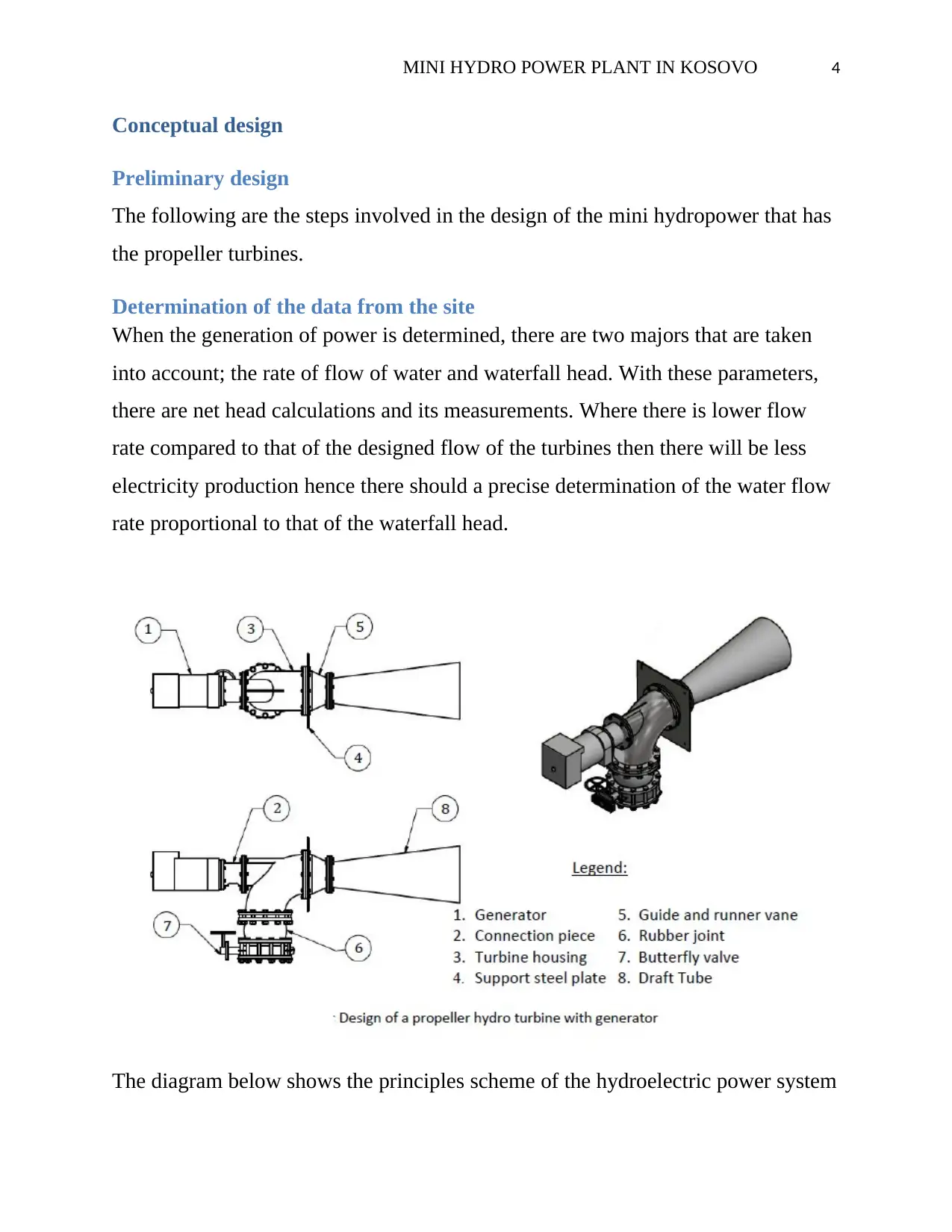
MINI HYDRO POWER PLANT IN KOSOVO 4
Conceptual design
Preliminary design
The following are the steps involved in the design of the mini hydropower that has
the propeller turbines.
Determination of the data from the site
When the generation of power is determined, there are two majors that are taken
into account; the rate of flow of water and waterfall head. With these parameters,
there are net head calculations and its measurements. Where there is lower flow
rate compared to that of the designed flow of the turbines then there will be less
electricity production hence there should a precise determination of the water flow
rate proportional to that of the waterfall head.
The diagram below shows the principles scheme of the hydroelectric power system
Conceptual design
Preliminary design
The following are the steps involved in the design of the mini hydropower that has
the propeller turbines.
Determination of the data from the site
When the generation of power is determined, there are two majors that are taken
into account; the rate of flow of water and waterfall head. With these parameters,
there are net head calculations and its measurements. Where there is lower flow
rate compared to that of the designed flow of the turbines then there will be less
electricity production hence there should a precise determination of the water flow
rate proportional to that of the waterfall head.
The diagram below shows the principles scheme of the hydroelectric power system
Secure Best Marks with AI Grader
Need help grading? Try our AI Grader for instant feedback on your assignments.
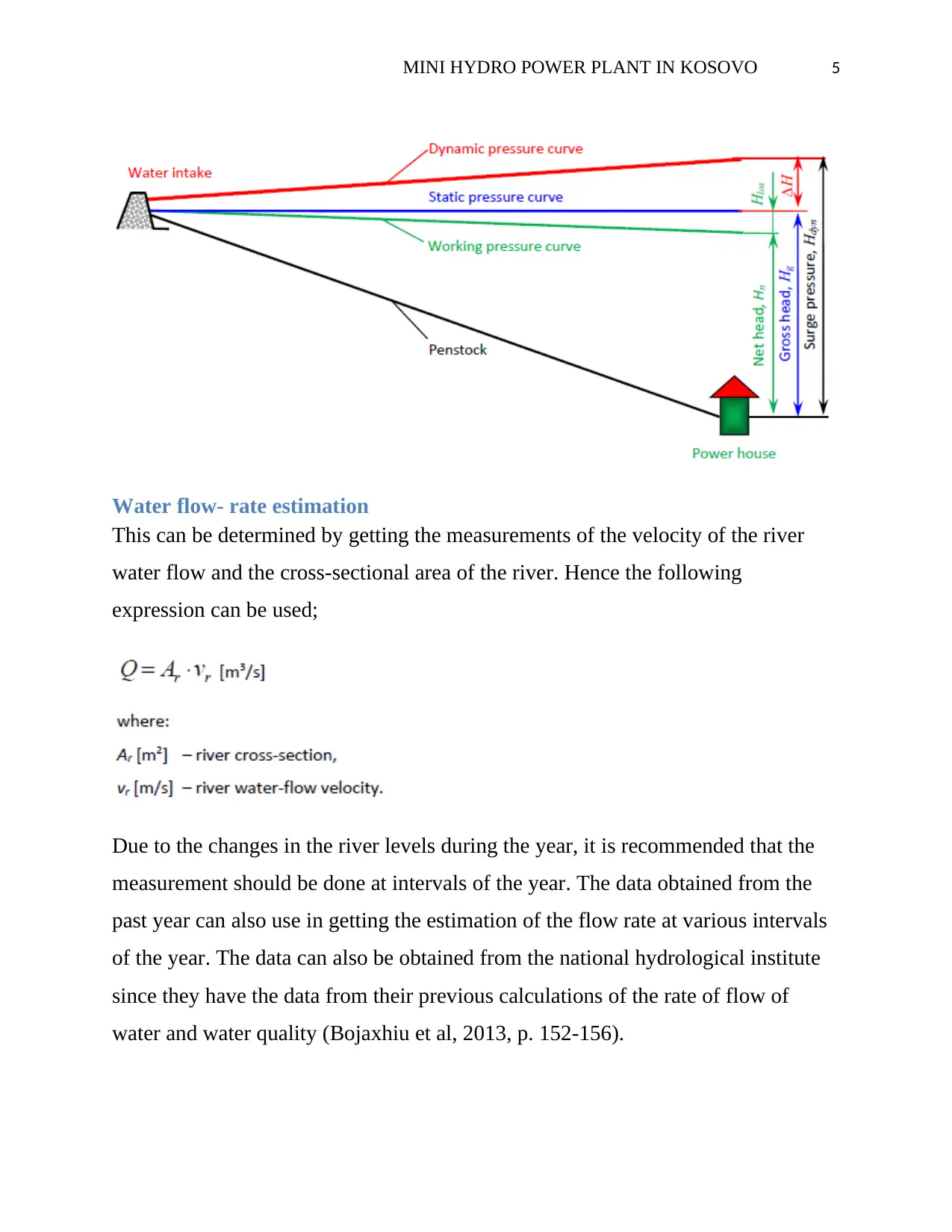
MINI HYDRO POWER PLANT IN KOSOVO 5
Water flow- rate estimation
This can be determined by getting the measurements of the velocity of the river
water flow and the cross-sectional area of the river. Hence the following
expression can be used;
Due to the changes in the river levels during the year, it is recommended that the
measurement should be done at intervals of the year. The data obtained from the
past year can also use in getting the estimation of the flow rate at various intervals
of the year. The data can also be obtained from the national hydrological institute
since they have the data from their previous calculations of the rate of flow of
water and water quality (Bojaxhiu et al, 2013, p. 152-156).
Water flow- rate estimation
This can be determined by getting the measurements of the velocity of the river
water flow and the cross-sectional area of the river. Hence the following
expression can be used;
Due to the changes in the river levels during the year, it is recommended that the
measurement should be done at intervals of the year. The data obtained from the
past year can also use in getting the estimation of the flow rate at various intervals
of the year. The data can also be obtained from the national hydrological institute
since they have the data from their previous calculations of the rate of flow of
water and water quality (Bojaxhiu et al, 2013, p. 152-156).
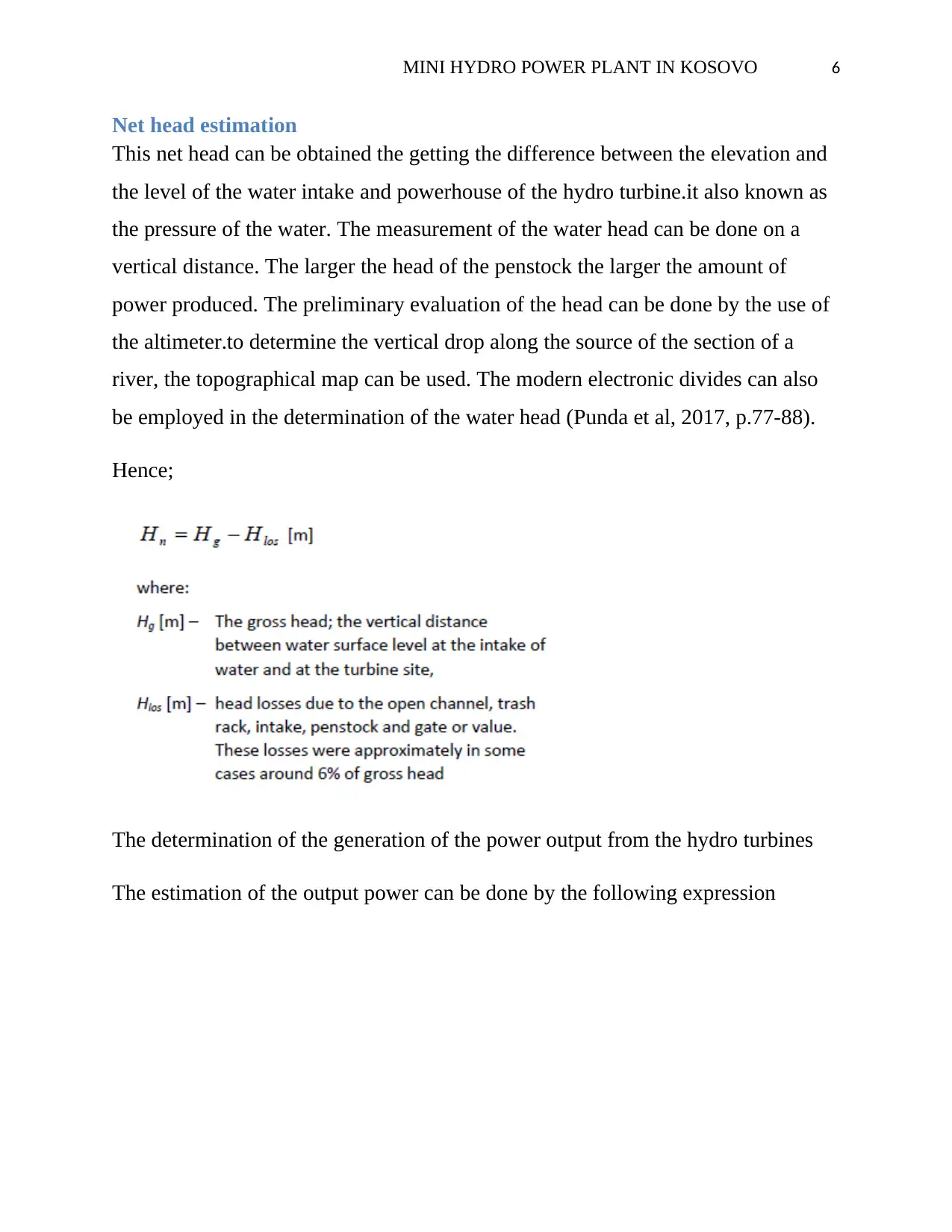
MINI HYDRO POWER PLANT IN KOSOVO 6
Net head estimation
This net head can be obtained the getting the difference between the elevation and
the level of the water intake and powerhouse of the hydro turbine.it also known as
the pressure of the water. The measurement of the water head can be done on a
vertical distance. The larger the head of the penstock the larger the amount of
power produced. The preliminary evaluation of the head can be done by the use of
the altimeter.to determine the vertical drop along the source of the section of a
river, the topographical map can be used. The modern electronic divides can also
be employed in the determination of the water head (Punda et al, 2017, p.77-88).
Hence;
The determination of the generation of the power output from the hydro turbines
The estimation of the output power can be done by the following expression
Net head estimation
This net head can be obtained the getting the difference between the elevation and
the level of the water intake and powerhouse of the hydro turbine.it also known as
the pressure of the water. The measurement of the water head can be done on a
vertical distance. The larger the head of the penstock the larger the amount of
power produced. The preliminary evaluation of the head can be done by the use of
the altimeter.to determine the vertical drop along the source of the section of a
river, the topographical map can be used. The modern electronic divides can also
be employed in the determination of the water head (Punda et al, 2017, p.77-88).
Hence;
The determination of the generation of the power output from the hydro turbines
The estimation of the output power can be done by the following expression
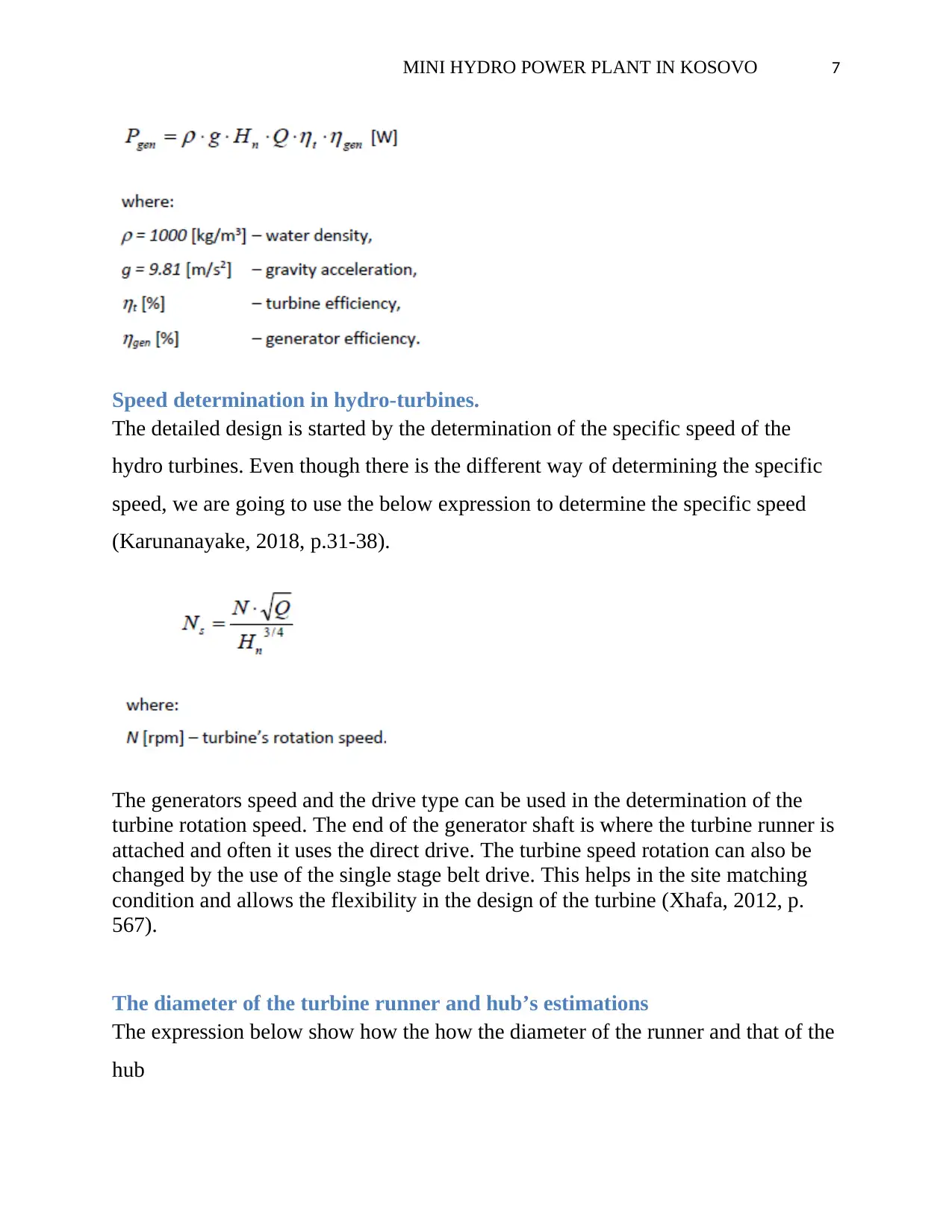
MINI HYDRO POWER PLANT IN KOSOVO 7
Speed determination in hydro-turbines.
The detailed design is started by the determination of the specific speed of the
hydro turbines. Even though there is the different way of determining the specific
speed, we are going to use the below expression to determine the specific speed
(Karunanayake, 2018, p.31-38).
The generators speed and the drive type can be used in the determination of the
turbine rotation speed. The end of the generator shaft is where the turbine runner is
attached and often it uses the direct drive. The turbine speed rotation can also be
changed by the use of the single stage belt drive. This helps in the site matching
condition and allows the flexibility in the design of the turbine (Xhafa, 2012, p.
567).
The diameter of the turbine runner and hub’s estimations
The expression below show how the how the diameter of the runner and that of the
hub
Speed determination in hydro-turbines.
The detailed design is started by the determination of the specific speed of the
hydro turbines. Even though there is the different way of determining the specific
speed, we are going to use the below expression to determine the specific speed
(Karunanayake, 2018, p.31-38).
The generators speed and the drive type can be used in the determination of the
turbine rotation speed. The end of the generator shaft is where the turbine runner is
attached and often it uses the direct drive. The turbine speed rotation can also be
changed by the use of the single stage belt drive. This helps in the site matching
condition and allows the flexibility in the design of the turbine (Xhafa, 2012, p.
567).
The diameter of the turbine runner and hub’s estimations
The expression below show how the how the diameter of the runner and that of the
hub
Paraphrase This Document
Need a fresh take? Get an instant paraphrase of this document with our AI Paraphraser
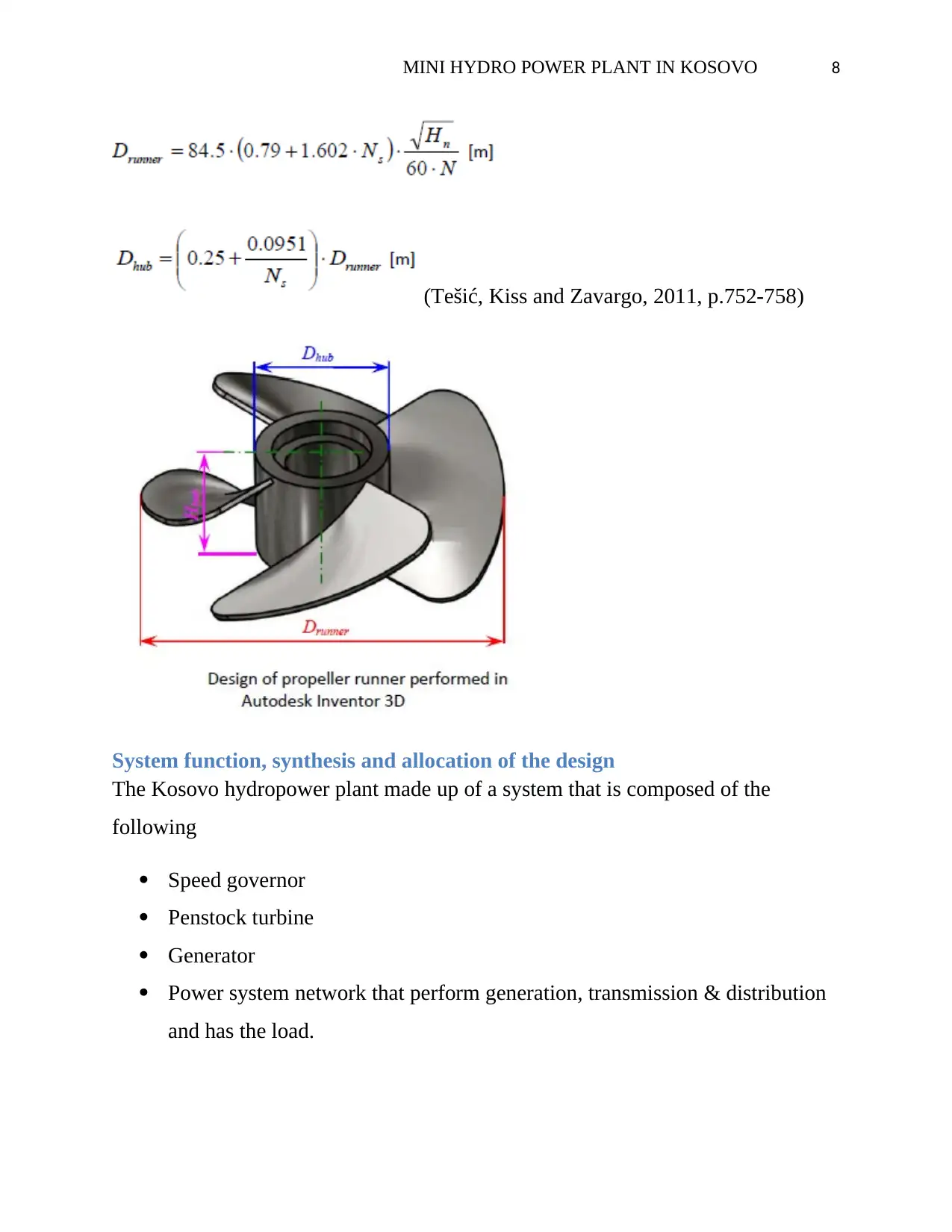
MINI HYDRO POWER PLANT IN KOSOVO 8
(Tešić, Kiss and Zavargo, 2011, p.752-758)
System function, synthesis and allocation of the design
The Kosovo hydropower plant made up of a system that is composed of the
following
Speed governor
Penstock turbine
Generator
Power system network that perform generation, transmission & distribution
and has the load.
(Tešić, Kiss and Zavargo, 2011, p.752-758)
System function, synthesis and allocation of the design
The Kosovo hydropower plant made up of a system that is composed of the
following
Speed governor
Penstock turbine
Generator
Power system network that perform generation, transmission & distribution
and has the load.
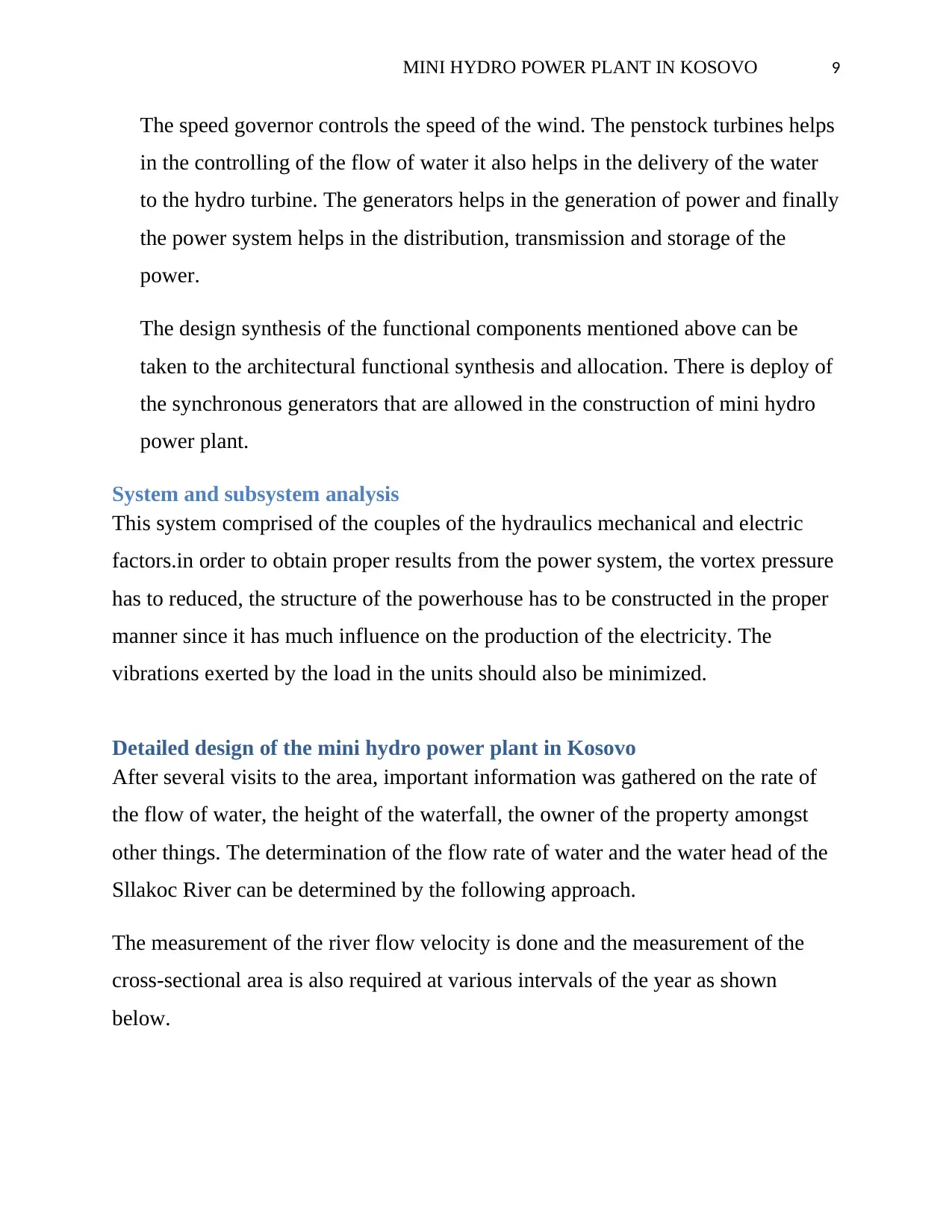
MINI HYDRO POWER PLANT IN KOSOVO 9
The speed governor controls the speed of the wind. The penstock turbines helps
in the controlling of the flow of water it also helps in the delivery of the water
to the hydro turbine. The generators helps in the generation of power and finally
the power system helps in the distribution, transmission and storage of the
power.
The design synthesis of the functional components mentioned above can be
taken to the architectural functional synthesis and allocation. There is deploy of
the synchronous generators that are allowed in the construction of mini hydro
power plant.
System and subsystem analysis
This system comprised of the couples of the hydraulics mechanical and electric
factors.in order to obtain proper results from the power system, the vortex pressure
has to reduced, the structure of the powerhouse has to be constructed in the proper
manner since it has much influence on the production of the electricity. The
vibrations exerted by the load in the units should also be minimized.
Detailed design of the mini hydro power plant in Kosovo
After several visits to the area, important information was gathered on the rate of
the flow of water, the height of the waterfall, the owner of the property amongst
other things. The determination of the flow rate of water and the water head of the
Sllakoc River can be determined by the following approach.
The measurement of the river flow velocity is done and the measurement of the
cross-sectional area is also required at various intervals of the year as shown
below.
The speed governor controls the speed of the wind. The penstock turbines helps
in the controlling of the flow of water it also helps in the delivery of the water
to the hydro turbine. The generators helps in the generation of power and finally
the power system helps in the distribution, transmission and storage of the
power.
The design synthesis of the functional components mentioned above can be
taken to the architectural functional synthesis and allocation. There is deploy of
the synchronous generators that are allowed in the construction of mini hydro
power plant.
System and subsystem analysis
This system comprised of the couples of the hydraulics mechanical and electric
factors.in order to obtain proper results from the power system, the vortex pressure
has to reduced, the structure of the powerhouse has to be constructed in the proper
manner since it has much influence on the production of the electricity. The
vibrations exerted by the load in the units should also be minimized.
Detailed design of the mini hydro power plant in Kosovo
After several visits to the area, important information was gathered on the rate of
the flow of water, the height of the waterfall, the owner of the property amongst
other things. The determination of the flow rate of water and the water head of the
Sllakoc River can be determined by the following approach.
The measurement of the river flow velocity is done and the measurement of the
cross-sectional area is also required at various intervals of the year as shown
below.
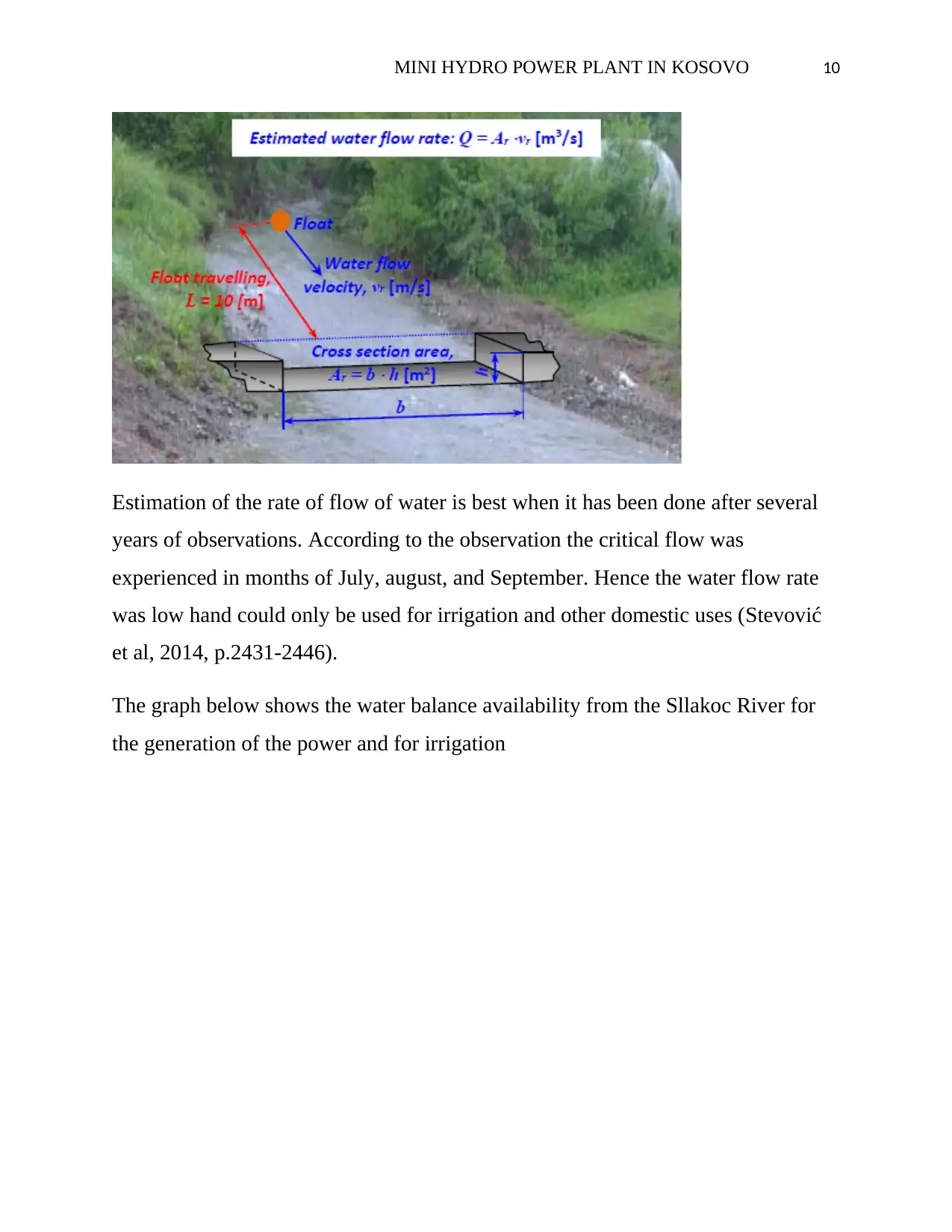
MINI HYDRO POWER PLANT IN KOSOVO 10
Estimation of the rate of flow of water is best when it has been done after several
years of observations. According to the observation the critical flow was
experienced in months of July, august, and September. Hence the water flow rate
was low hand could only be used for irrigation and other domestic uses (Stevović
et al, 2014, p.2431-2446).
The graph below shows the water balance availability from the Sllakoc River for
the generation of the power and for irrigation
Estimation of the rate of flow of water is best when it has been done after several
years of observations. According to the observation the critical flow was
experienced in months of July, august, and September. Hence the water flow rate
was low hand could only be used for irrigation and other domestic uses (Stevović
et al, 2014, p.2431-2446).
The graph below shows the water balance availability from the Sllakoc River for
the generation of the power and for irrigation
Secure Best Marks with AI Grader
Need help grading? Try our AI Grader for instant feedback on your assignments.
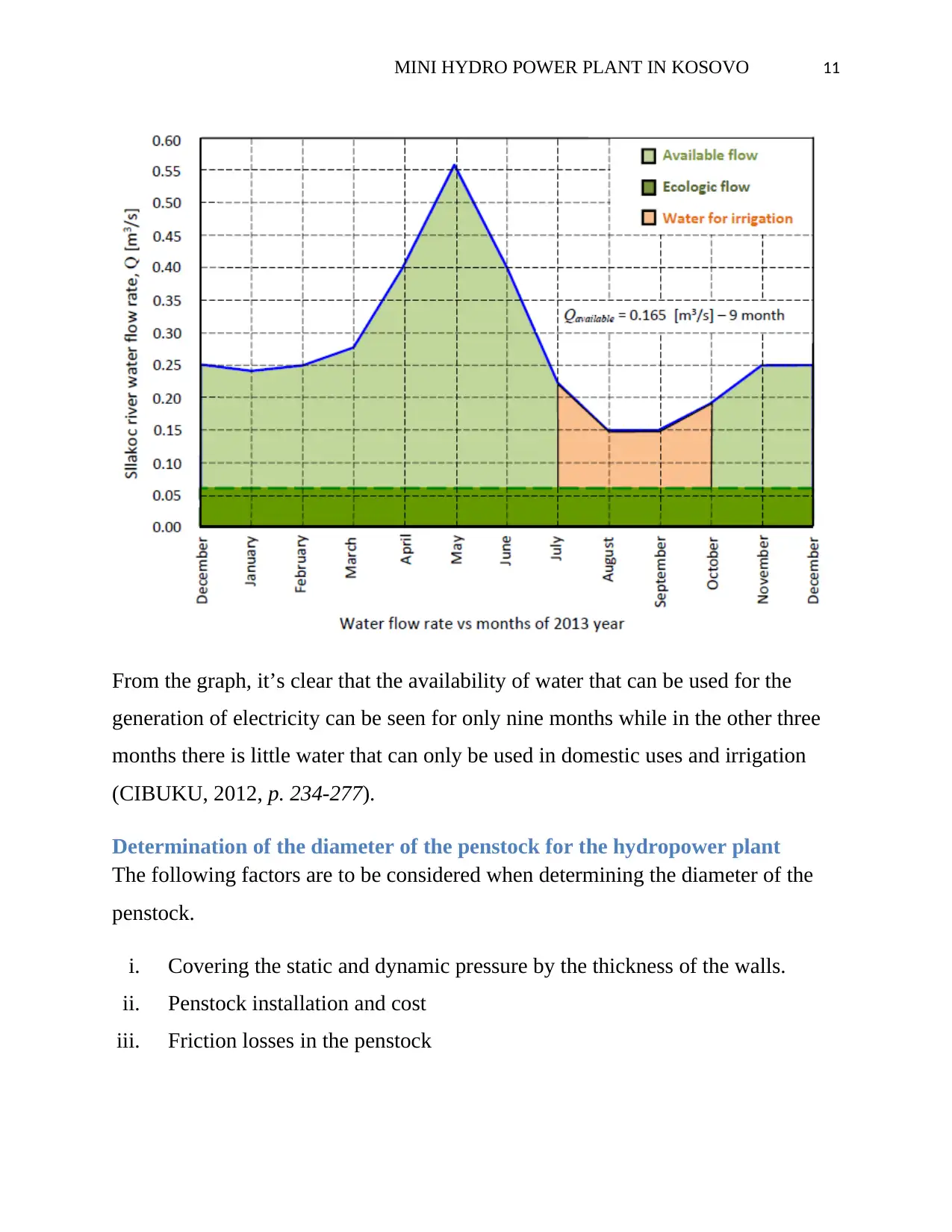
MINI HYDRO POWER PLANT IN KOSOVO 11
From the graph, it’s clear that the availability of water that can be used for the
generation of electricity can be seen for only nine months while in the other three
months there is little water that can only be used in domestic uses and irrigation
(CIBUKU, 2012, p. 234-277).
Determination of the diameter of the penstock for the hydropower plant
The following factors are to be considered when determining the diameter of the
penstock.
i. Covering the static and dynamic pressure by the thickness of the walls.
ii. Penstock installation and cost
iii. Friction losses in the penstock
From the graph, it’s clear that the availability of water that can be used for the
generation of electricity can be seen for only nine months while in the other three
months there is little water that can only be used in domestic uses and irrigation
(CIBUKU, 2012, p. 234-277).
Determination of the diameter of the penstock for the hydropower plant
The following factors are to be considered when determining the diameter of the
penstock.
i. Covering the static and dynamic pressure by the thickness of the walls.
ii. Penstock installation and cost
iii. Friction losses in the penstock
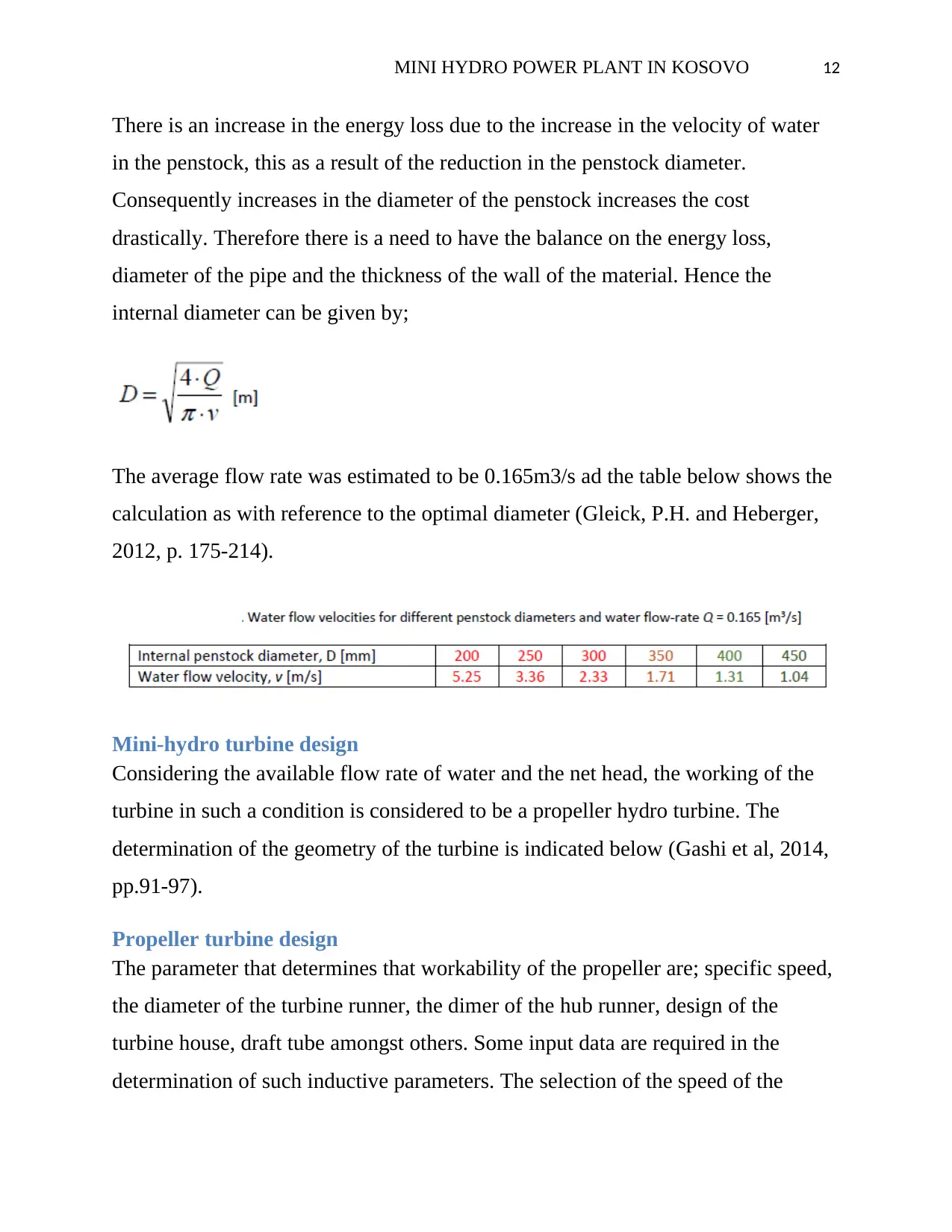
MINI HYDRO POWER PLANT IN KOSOVO 12
There is an increase in the energy loss due to the increase in the velocity of water
in the penstock, this as a result of the reduction in the penstock diameter.
Consequently increases in the diameter of the penstock increases the cost
drastically. Therefore there is a need to have the balance on the energy loss,
diameter of the pipe and the thickness of the wall of the material. Hence the
internal diameter can be given by;
The average flow rate was estimated to be 0.165m3/s ad the table below shows the
calculation as with reference to the optimal diameter (Gleick, P.H. and Heberger,
2012, p. 175-214).
Mini-hydro turbine design
Considering the available flow rate of water and the net head, the working of the
turbine in such a condition is considered to be a propeller hydro turbine. The
determination of the geometry of the turbine is indicated below (Gashi et al, 2014,
pp.91-97).
Propeller turbine design
The parameter that determines that workability of the propeller are; specific speed,
the diameter of the turbine runner, the dimer of the hub runner, design of the
turbine house, draft tube amongst others. Some input data are required in the
determination of such inductive parameters. The selection of the speed of the
There is an increase in the energy loss due to the increase in the velocity of water
in the penstock, this as a result of the reduction in the penstock diameter.
Consequently increases in the diameter of the penstock increases the cost
drastically. Therefore there is a need to have the balance on the energy loss,
diameter of the pipe and the thickness of the wall of the material. Hence the
internal diameter can be given by;
The average flow rate was estimated to be 0.165m3/s ad the table below shows the
calculation as with reference to the optimal diameter (Gleick, P.H. and Heberger,
2012, p. 175-214).
Mini-hydro turbine design
Considering the available flow rate of water and the net head, the working of the
turbine in such a condition is considered to be a propeller hydro turbine. The
determination of the geometry of the turbine is indicated below (Gashi et al, 2014,
pp.91-97).
Propeller turbine design
The parameter that determines that workability of the propeller are; specific speed,
the diameter of the turbine runner, the dimer of the hub runner, design of the
turbine house, draft tube amongst others. Some input data are required in the
determination of such inductive parameters. The selection of the speed of the
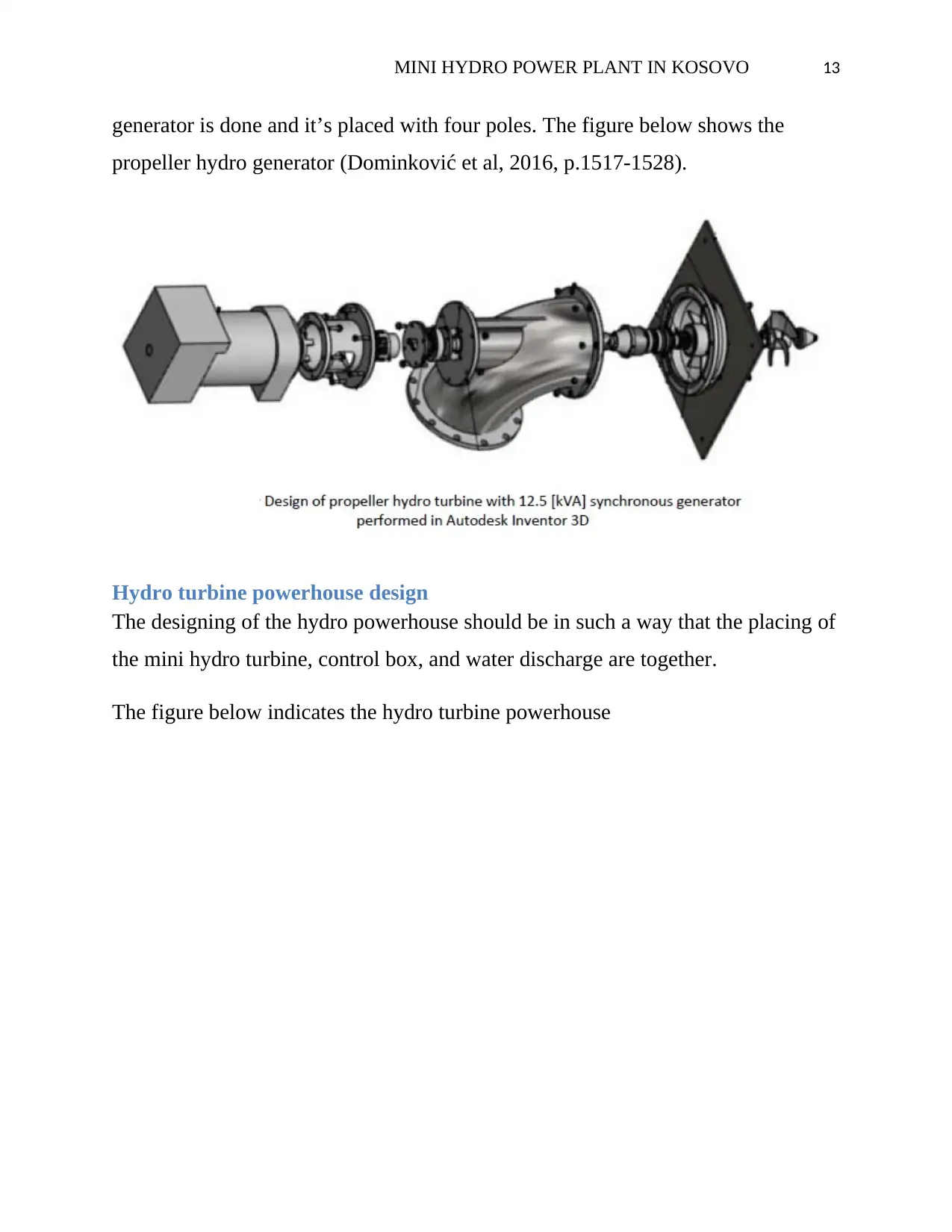
MINI HYDRO POWER PLANT IN KOSOVO 13
generator is done and it’s placed with four poles. The figure below shows the
propeller hydro generator (Dominković et al, 2016, p.1517-1528).
Hydro turbine powerhouse design
The designing of the hydro powerhouse should be in such a way that the placing of
the mini hydro turbine, control box, and water discharge are together.
The figure below indicates the hydro turbine powerhouse
generator is done and it’s placed with four poles. The figure below shows the
propeller hydro generator (Dominković et al, 2016, p.1517-1528).
Hydro turbine powerhouse design
The designing of the hydro powerhouse should be in such a way that the placing of
the mini hydro turbine, control box, and water discharge are together.
The figure below indicates the hydro turbine powerhouse
Paraphrase This Document
Need a fresh take? Get an instant paraphrase of this document with our AI Paraphraser
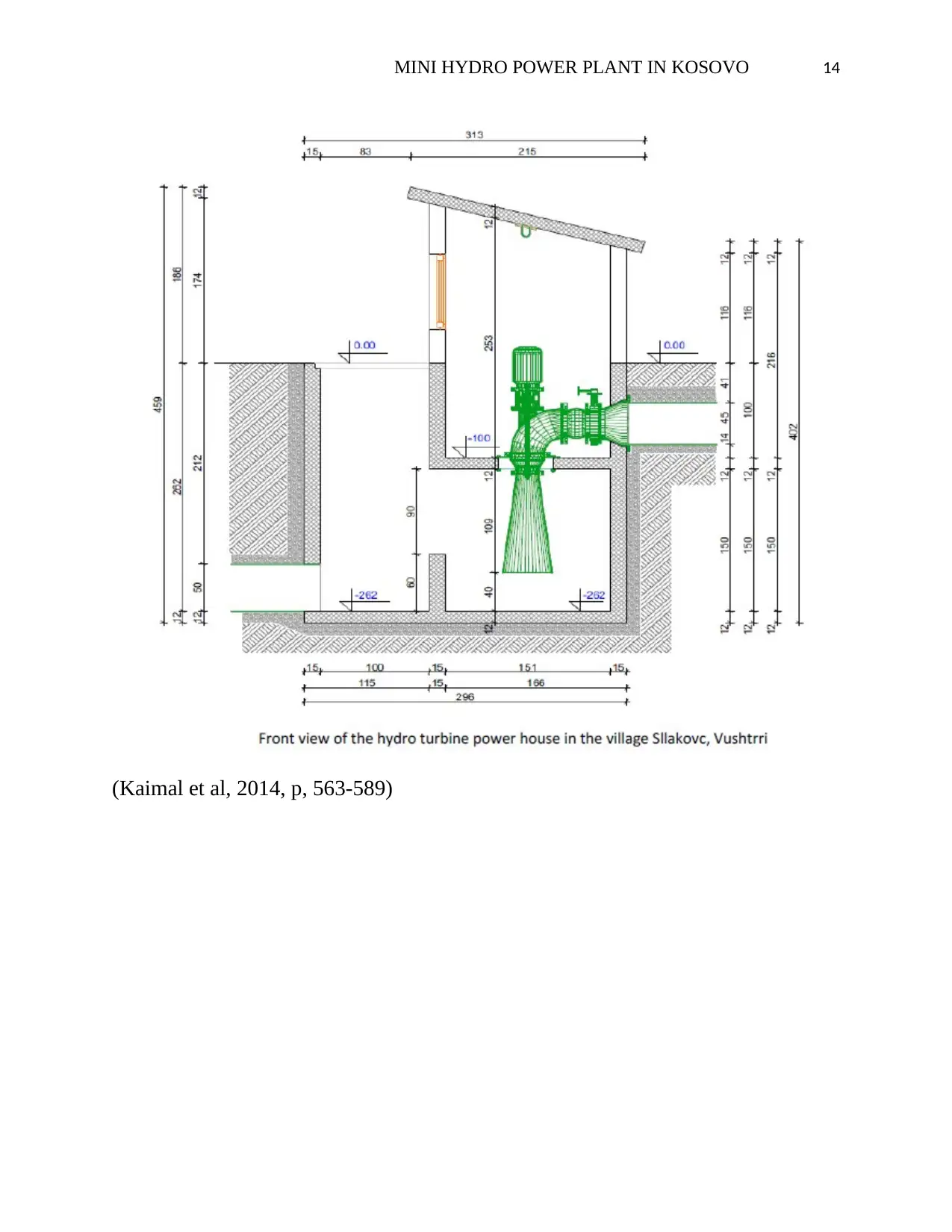
MINI HYDRO POWER PLANT IN KOSOVO 14
(Kaimal et al, 2014, p, 563-589)
(Kaimal et al, 2014, p, 563-589)
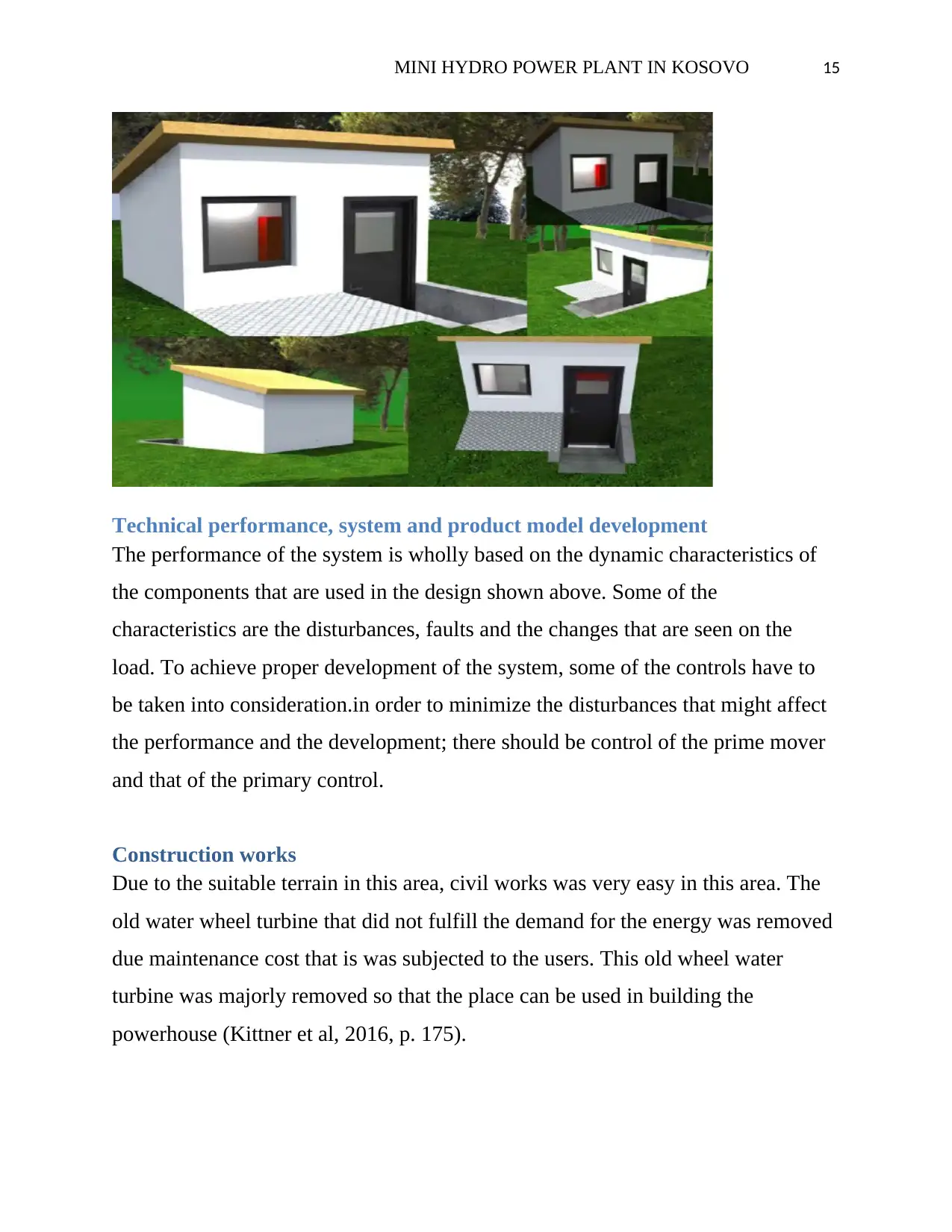
MINI HYDRO POWER PLANT IN KOSOVO 15
Technical performance, system and product model development
The performance of the system is wholly based on the dynamic characteristics of
the components that are used in the design shown above. Some of the
characteristics are the disturbances, faults and the changes that are seen on the
load. To achieve proper development of the system, some of the controls have to
be taken into consideration.in order to minimize the disturbances that might affect
the performance and the development; there should be control of the prime mover
and that of the primary control.
Construction works
Due to the suitable terrain in this area, civil works was very easy in this area. The
old water wheel turbine that did not fulfill the demand for the energy was removed
due maintenance cost that is was subjected to the users. This old wheel water
turbine was majorly removed so that the place can be used in building the
powerhouse (Kittner et al, 2016, p. 175).
Technical performance, system and product model development
The performance of the system is wholly based on the dynamic characteristics of
the components that are used in the design shown above. Some of the
characteristics are the disturbances, faults and the changes that are seen on the
load. To achieve proper development of the system, some of the controls have to
be taken into consideration.in order to minimize the disturbances that might affect
the performance and the development; there should be control of the prime mover
and that of the primary control.
Construction works
Due to the suitable terrain in this area, civil works was very easy in this area. The
old water wheel turbine that did not fulfill the demand for the energy was removed
due maintenance cost that is was subjected to the users. This old wheel water
turbine was majorly removed so that the place can be used in building the
powerhouse (Kittner et al, 2016, p. 175).
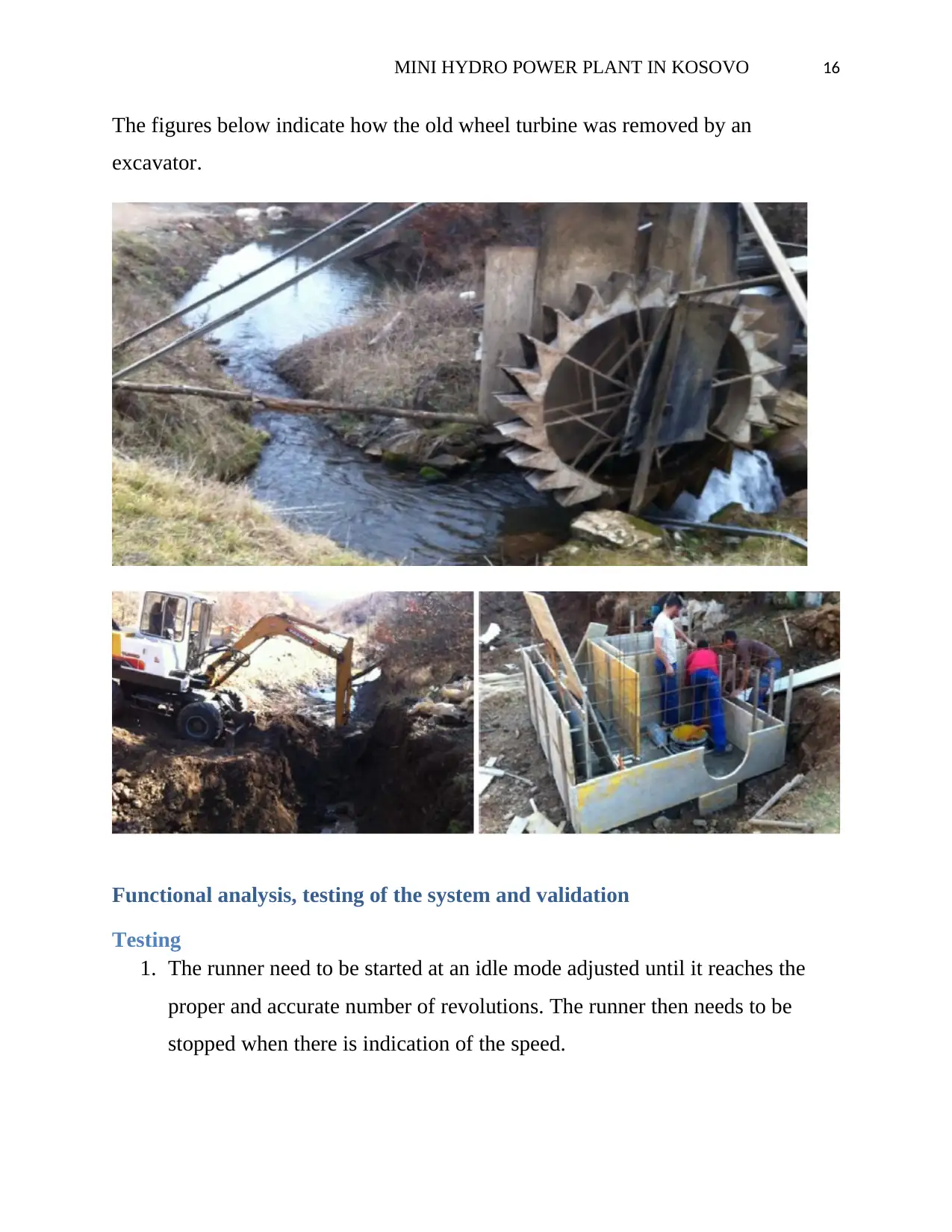
MINI HYDRO POWER PLANT IN KOSOVO 16
The figures below indicate how the old wheel turbine was removed by an
excavator.
Functional analysis, testing of the system and validation
Testing
1. The runner need to be started at an idle mode adjusted until it reaches the
proper and accurate number of revolutions. The runner then needs to be
stopped when there is indication of the speed.
The figures below indicate how the old wheel turbine was removed by an
excavator.
Functional analysis, testing of the system and validation
Testing
1. The runner need to be started at an idle mode adjusted until it reaches the
proper and accurate number of revolutions. The runner then needs to be
stopped when there is indication of the speed.
Secure Best Marks with AI Grader
Need help grading? Try our AI Grader for instant feedback on your assignments.
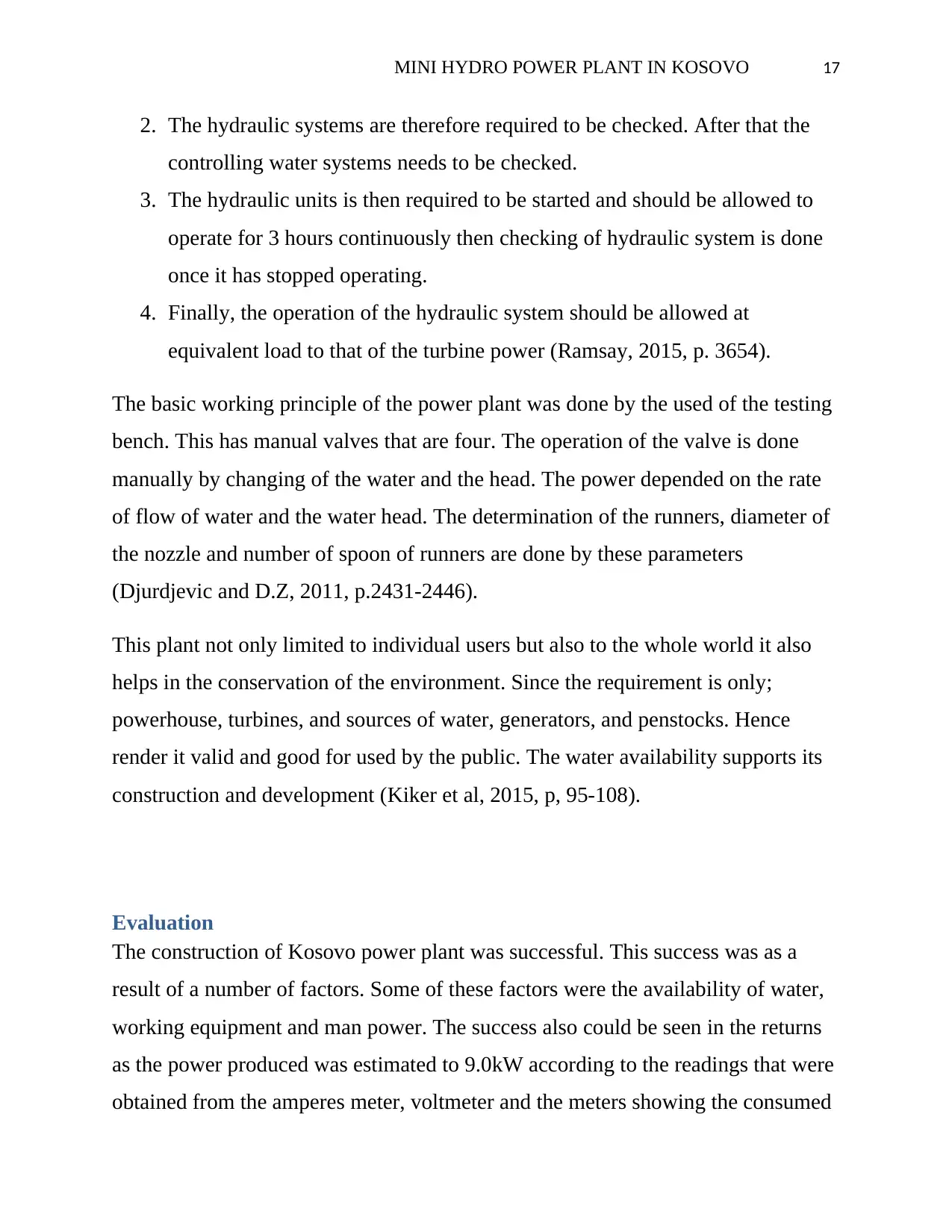
MINI HYDRO POWER PLANT IN KOSOVO 17
2. The hydraulic systems are therefore required to be checked. After that the
controlling water systems needs to be checked.
3. The hydraulic units is then required to be started and should be allowed to
operate for 3 hours continuously then checking of hydraulic system is done
once it has stopped operating.
4. Finally, the operation of the hydraulic system should be allowed at
equivalent load to that of the turbine power (Ramsay, 2015, p. 3654).
The basic working principle of the power plant was done by the used of the testing
bench. This has manual valves that are four. The operation of the valve is done
manually by changing of the water and the head. The power depended on the rate
of flow of water and the water head. The determination of the runners, diameter of
the nozzle and number of spoon of runners are done by these parameters
(Djurdjevic and D.Z, 2011, p.2431-2446).
This plant not only limited to individual users but also to the whole world it also
helps in the conservation of the environment. Since the requirement is only;
powerhouse, turbines, and sources of water, generators, and penstocks. Hence
render it valid and good for used by the public. The water availability supports its
construction and development (Kiker et al, 2015, p, 95-108).
Evaluation
The construction of Kosovo power plant was successful. This success was as a
result of a number of factors. Some of these factors were the availability of water,
working equipment and man power. The success also could be seen in the returns
as the power produced was estimated to 9.0kW according to the readings that were
obtained from the amperes meter, voltmeter and the meters showing the consumed
2. The hydraulic systems are therefore required to be checked. After that the
controlling water systems needs to be checked.
3. The hydraulic units is then required to be started and should be allowed to
operate for 3 hours continuously then checking of hydraulic system is done
once it has stopped operating.
4. Finally, the operation of the hydraulic system should be allowed at
equivalent load to that of the turbine power (Ramsay, 2015, p. 3654).
The basic working principle of the power plant was done by the used of the testing
bench. This has manual valves that are four. The operation of the valve is done
manually by changing of the water and the head. The power depended on the rate
of flow of water and the water head. The determination of the runners, diameter of
the nozzle and number of spoon of runners are done by these parameters
(Djurdjevic and D.Z, 2011, p.2431-2446).
This plant not only limited to individual users but also to the whole world it also
helps in the conservation of the environment. Since the requirement is only;
powerhouse, turbines, and sources of water, generators, and penstocks. Hence
render it valid and good for used by the public. The water availability supports its
construction and development (Kiker et al, 2015, p, 95-108).
Evaluation
The construction of Kosovo power plant was successful. This success was as a
result of a number of factors. Some of these factors were the availability of water,
working equipment and man power. The success also could be seen in the returns
as the power produced was estimated to 9.0kW according to the readings that were
obtained from the amperes meter, voltmeter and the meters showing the consumed
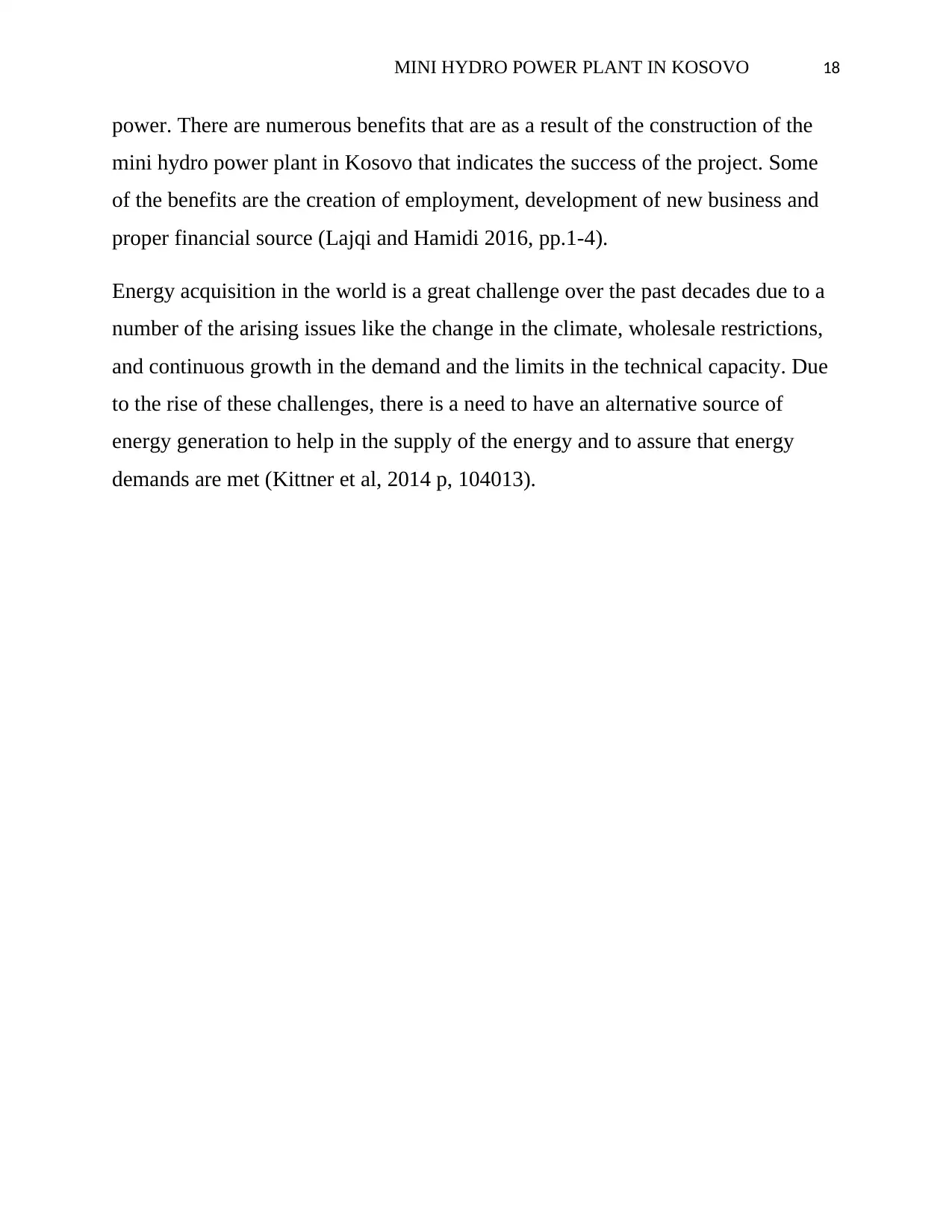
MINI HYDRO POWER PLANT IN KOSOVO 18
power. There are numerous benefits that are as a result of the construction of the
mini hydro power plant in Kosovo that indicates the success of the project. Some
of the benefits are the creation of employment, development of new business and
proper financial source (Lajqi and Hamidi 2016, pp.1-4).
Energy acquisition in the world is a great challenge over the past decades due to a
number of the arising issues like the change in the climate, wholesale restrictions,
and continuous growth in the demand and the limits in the technical capacity. Due
to the rise of these challenges, there is a need to have an alternative source of
energy generation to help in the supply of the energy and to assure that energy
demands are met (Kittner et al, 2014 p, 104013).
power. There are numerous benefits that are as a result of the construction of the
mini hydro power plant in Kosovo that indicates the success of the project. Some
of the benefits are the creation of employment, development of new business and
proper financial source (Lajqi and Hamidi 2016, pp.1-4).
Energy acquisition in the world is a great challenge over the past decades due to a
number of the arising issues like the change in the climate, wholesale restrictions,
and continuous growth in the demand and the limits in the technical capacity. Due
to the rise of these challenges, there is a need to have an alternative source of
energy generation to help in the supply of the energy and to assure that energy
demands are met (Kittner et al, 2014 p, 104013).
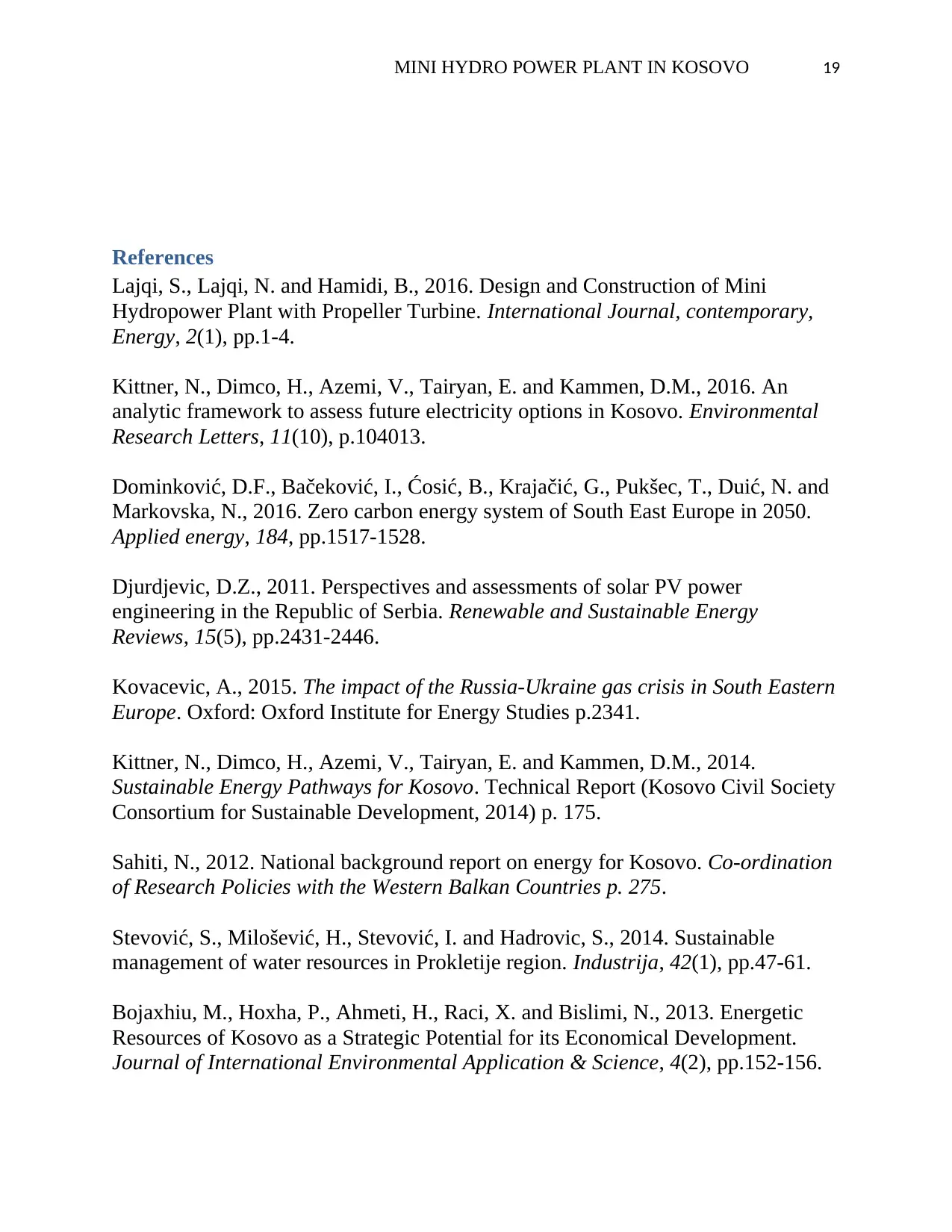
MINI HYDRO POWER PLANT IN KOSOVO 19
References
Lajqi, S., Lajqi, N. and Hamidi, B., 2016. Design and Construction of Mini
Hydropower Plant with Propeller Turbine. International Journal, contemporary,
Energy, 2(1), pp.1-4.
Kittner, N., Dimco, H., Azemi, V., Tairyan, E. and Kammen, D.M., 2016. An
analytic framework to assess future electricity options in Kosovo. Environmental
Research Letters, 11(10), p.104013.
Dominković, D.F., Bačeković, I., Ćosić, B., Krajačić, G., Pukšec, T., Duić, N. and
Markovska, N., 2016. Zero carbon energy system of South East Europe in 2050.
Applied energy, 184, pp.1517-1528.
Djurdjevic, D.Z., 2011. Perspectives and assessments of solar PV power
engineering in the Republic of Serbia. Renewable and Sustainable Energy
Reviews, 15(5), pp.2431-2446.
Kovacevic, A., 2015. The impact of the Russia-Ukraine gas crisis in South Eastern
Europe. Oxford: Oxford Institute for Energy Studies p.2341.
Kittner, N., Dimco, H., Azemi, V., Tairyan, E. and Kammen, D.M., 2014.
Sustainable Energy Pathways for Kosovo. Technical Report (Kosovo Civil Society
Consortium for Sustainable Development, 2014) p. 175.
Sahiti, N., 2012. National background report on energy for Kosovo. Co-ordination
of Research Policies with the Western Balkan Countries p. 275.
Stevović, S., Milošević, H., Stevović, I. and Hadrovic, S., 2014. Sustainable
management of water resources in Prokletije region. Industrija, 42(1), pp.47-61.
Bojaxhiu, M., Hoxha, P., Ahmeti, H., Raci, X. and Bislimi, N., 2013. Energetic
Resources of Kosovo as a Strategic Potential for its Economical Development.
Journal of International Environmental Application & Science, 4(2), pp.152-156.
References
Lajqi, S., Lajqi, N. and Hamidi, B., 2016. Design and Construction of Mini
Hydropower Plant with Propeller Turbine. International Journal, contemporary,
Energy, 2(1), pp.1-4.
Kittner, N., Dimco, H., Azemi, V., Tairyan, E. and Kammen, D.M., 2016. An
analytic framework to assess future electricity options in Kosovo. Environmental
Research Letters, 11(10), p.104013.
Dominković, D.F., Bačeković, I., Ćosić, B., Krajačić, G., Pukšec, T., Duić, N. and
Markovska, N., 2016. Zero carbon energy system of South East Europe in 2050.
Applied energy, 184, pp.1517-1528.
Djurdjevic, D.Z., 2011. Perspectives and assessments of solar PV power
engineering in the Republic of Serbia. Renewable and Sustainable Energy
Reviews, 15(5), pp.2431-2446.
Kovacevic, A., 2015. The impact of the Russia-Ukraine gas crisis in South Eastern
Europe. Oxford: Oxford Institute for Energy Studies p.2341.
Kittner, N., Dimco, H., Azemi, V., Tairyan, E. and Kammen, D.M., 2014.
Sustainable Energy Pathways for Kosovo. Technical Report (Kosovo Civil Society
Consortium for Sustainable Development, 2014) p. 175.
Sahiti, N., 2012. National background report on energy for Kosovo. Co-ordination
of Research Policies with the Western Balkan Countries p. 275.
Stevović, S., Milošević, H., Stevović, I. and Hadrovic, S., 2014. Sustainable
management of water resources in Prokletije region. Industrija, 42(1), pp.47-61.
Bojaxhiu, M., Hoxha, P., Ahmeti, H., Raci, X. and Bislimi, N., 2013. Energetic
Resources of Kosovo as a Strategic Potential for its Economical Development.
Journal of International Environmental Application & Science, 4(2), pp.152-156.
Paraphrase This Document
Need a fresh take? Get an instant paraphrase of this document with our AI Paraphraser
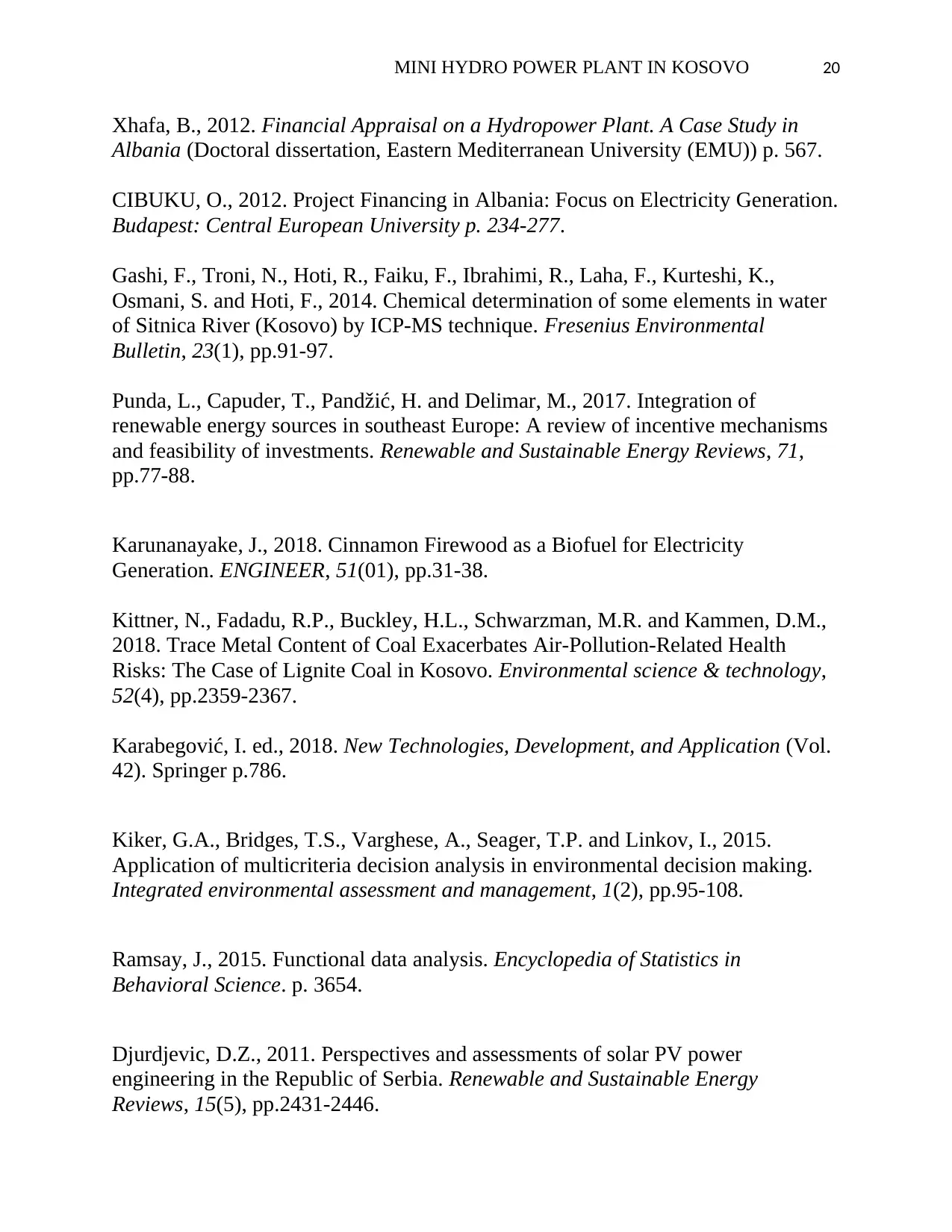
MINI HYDRO POWER PLANT IN KOSOVO 20
Xhafa, B., 2012. Financial Appraisal on a Hydropower Plant. A Case Study in
Albania (Doctoral dissertation, Eastern Mediterranean University (EMU)) p. 567.
CIBUKU, O., 2012. Project Financing in Albania: Focus on Electricity Generation.
Budapest: Central European University p. 234-277.
Gashi, F., Troni, N., Hoti, R., Faiku, F., Ibrahimi, R., Laha, F., Kurteshi, K.,
Osmani, S. and Hoti, F., 2014. Chemical determination of some elements in water
of Sitnica River (Kosovo) by ICP-MS technique. Fresenius Environmental
Bulletin, 23(1), pp.91-97.
Punda, L., Capuder, T., Pandžić, H. and Delimar, M., 2017. Integration of
renewable energy sources in southeast Europe: A review of incentive mechanisms
and feasibility of investments. Renewable and Sustainable Energy Reviews, 71,
pp.77-88.
Karunanayake, J., 2018. Cinnamon Firewood as a Biofuel for Electricity
Generation. ENGINEER, 51(01), pp.31-38.
Kittner, N., Fadadu, R.P., Buckley, H.L., Schwarzman, M.R. and Kammen, D.M.,
2018. Trace Metal Content of Coal Exacerbates Air-Pollution-Related Health
Risks: The Case of Lignite Coal in Kosovo. Environmental science & technology,
52(4), pp.2359-2367.
Karabegović, I. ed., 2018. New Technologies, Development, and Application (Vol.
42). Springer p.786.
Kiker, G.A., Bridges, T.S., Varghese, A., Seager, T.P. and Linkov, I., 2015.
Application of multicriteria decision analysis in environmental decision making.
Integrated environmental assessment and management, 1(2), pp.95-108.
Ramsay, J., 2015. Functional data analysis. Encyclopedia of Statistics in
Behavioral Science. p. 3654.
Djurdjevic, D.Z., 2011. Perspectives and assessments of solar PV power
engineering in the Republic of Serbia. Renewable and Sustainable Energy
Reviews, 15(5), pp.2431-2446.
Xhafa, B., 2012. Financial Appraisal on a Hydropower Plant. A Case Study in
Albania (Doctoral dissertation, Eastern Mediterranean University (EMU)) p. 567.
CIBUKU, O., 2012. Project Financing in Albania: Focus on Electricity Generation.
Budapest: Central European University p. 234-277.
Gashi, F., Troni, N., Hoti, R., Faiku, F., Ibrahimi, R., Laha, F., Kurteshi, K.,
Osmani, S. and Hoti, F., 2014. Chemical determination of some elements in water
of Sitnica River (Kosovo) by ICP-MS technique. Fresenius Environmental
Bulletin, 23(1), pp.91-97.
Punda, L., Capuder, T., Pandžić, H. and Delimar, M., 2017. Integration of
renewable energy sources in southeast Europe: A review of incentive mechanisms
and feasibility of investments. Renewable and Sustainable Energy Reviews, 71,
pp.77-88.
Karunanayake, J., 2018. Cinnamon Firewood as a Biofuel for Electricity
Generation. ENGINEER, 51(01), pp.31-38.
Kittner, N., Fadadu, R.P., Buckley, H.L., Schwarzman, M.R. and Kammen, D.M.,
2018. Trace Metal Content of Coal Exacerbates Air-Pollution-Related Health
Risks: The Case of Lignite Coal in Kosovo. Environmental science & technology,
52(4), pp.2359-2367.
Karabegović, I. ed., 2018. New Technologies, Development, and Application (Vol.
42). Springer p.786.
Kiker, G.A., Bridges, T.S., Varghese, A., Seager, T.P. and Linkov, I., 2015.
Application of multicriteria decision analysis in environmental decision making.
Integrated environmental assessment and management, 1(2), pp.95-108.
Ramsay, J., 2015. Functional data analysis. Encyclopedia of Statistics in
Behavioral Science. p. 3654.
Djurdjevic, D.Z., 2011. Perspectives and assessments of solar PV power
engineering in the Republic of Serbia. Renewable and Sustainable Energy
Reviews, 15(5), pp.2431-2446.
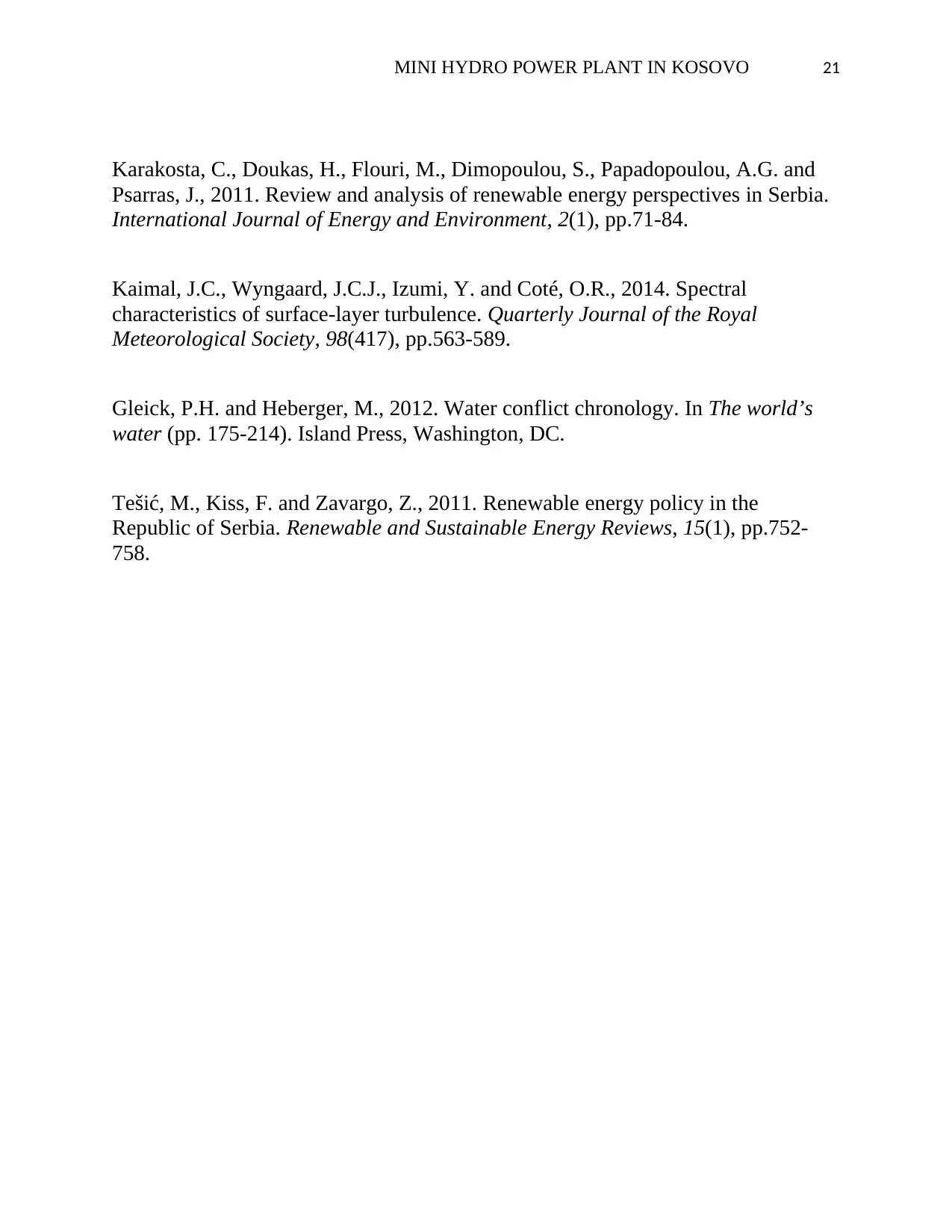
MINI HYDRO POWER PLANT IN KOSOVO 21
Karakosta, C., Doukas, H., Flouri, M., Dimopoulou, S., Papadopoulou, A.G. and
Psarras, J., 2011. Review and analysis of renewable energy perspectives in Serbia.
International Journal of Energy and Environment, 2(1), pp.71-84.
Kaimal, J.C., Wyngaard, J.C.J., Izumi, Y. and Coté, O.R., 2014. Spectral
characteristics of surface‐layer turbulence. Quarterly Journal of the Royal
Meteorological Society, 98(417), pp.563-589.
Gleick, P.H. and Heberger, M., 2012. Water conflict chronology. In The world’s
water (pp. 175-214). Island Press, Washington, DC.
Tešić, M., Kiss, F. and Zavargo, Z., 2011. Renewable energy policy in the
Republic of Serbia. Renewable and Sustainable Energy Reviews, 15(1), pp.752-
758.
Karakosta, C., Doukas, H., Flouri, M., Dimopoulou, S., Papadopoulou, A.G. and
Psarras, J., 2011. Review and analysis of renewable energy perspectives in Serbia.
International Journal of Energy and Environment, 2(1), pp.71-84.
Kaimal, J.C., Wyngaard, J.C.J., Izumi, Y. and Coté, O.R., 2014. Spectral
characteristics of surface‐layer turbulence. Quarterly Journal of the Royal
Meteorological Society, 98(417), pp.563-589.
Gleick, P.H. and Heberger, M., 2012. Water conflict chronology. In The world’s
water (pp. 175-214). Island Press, Washington, DC.
Tešić, M., Kiss, F. and Zavargo, Z., 2011. Renewable energy policy in the
Republic of Serbia. Renewable and Sustainable Energy Reviews, 15(1), pp.752-
758.
1 out of 21
Related Documents
Your All-in-One AI-Powered Toolkit for Academic Success.
+13062052269
info@desklib.com
Available 24*7 on WhatsApp / Email
![[object Object]](/_next/static/media/star-bottom.7253800d.svg)
Unlock your academic potential
© 2024 | Zucol Services PVT LTD | All rights reserved.





